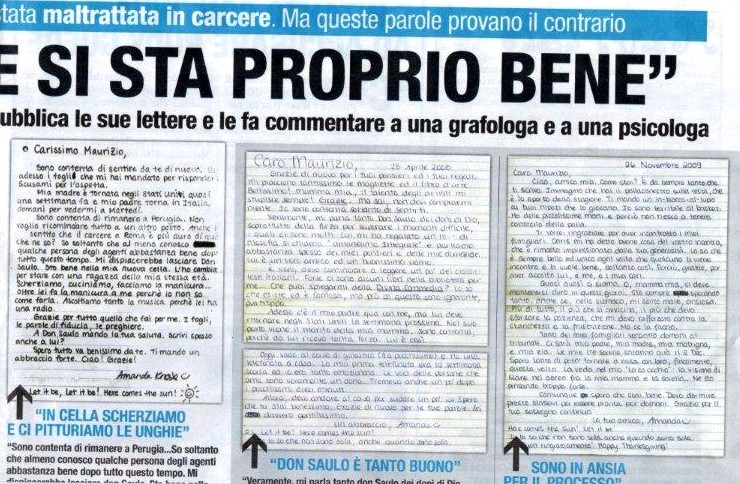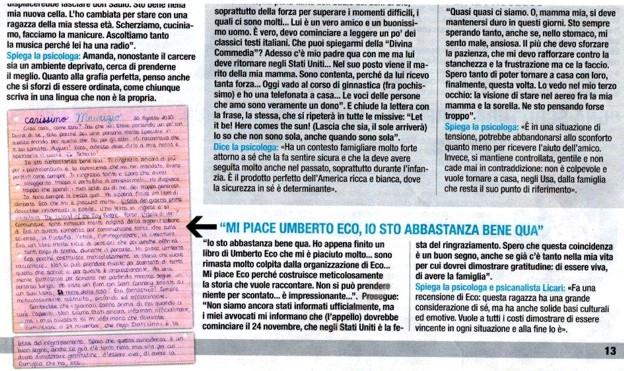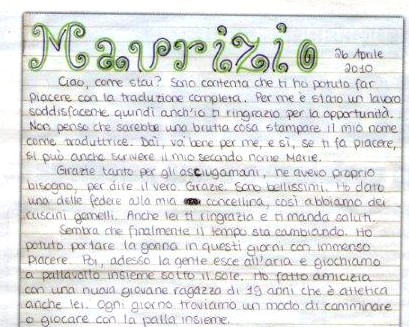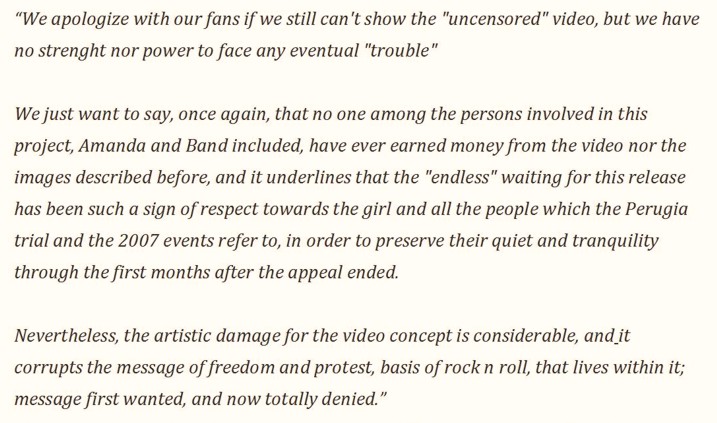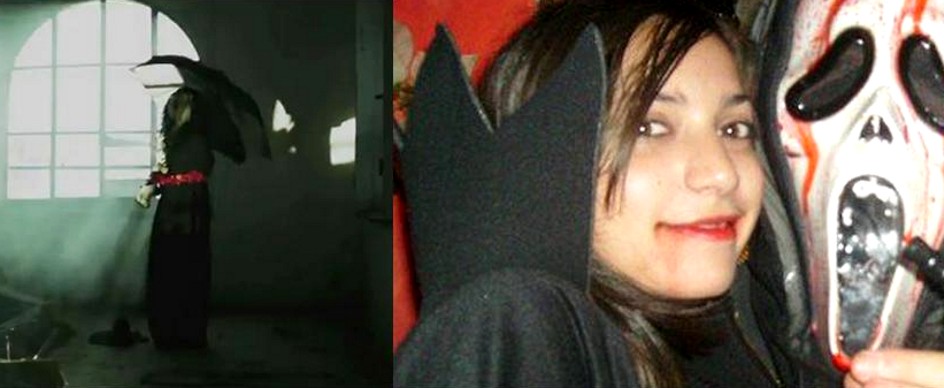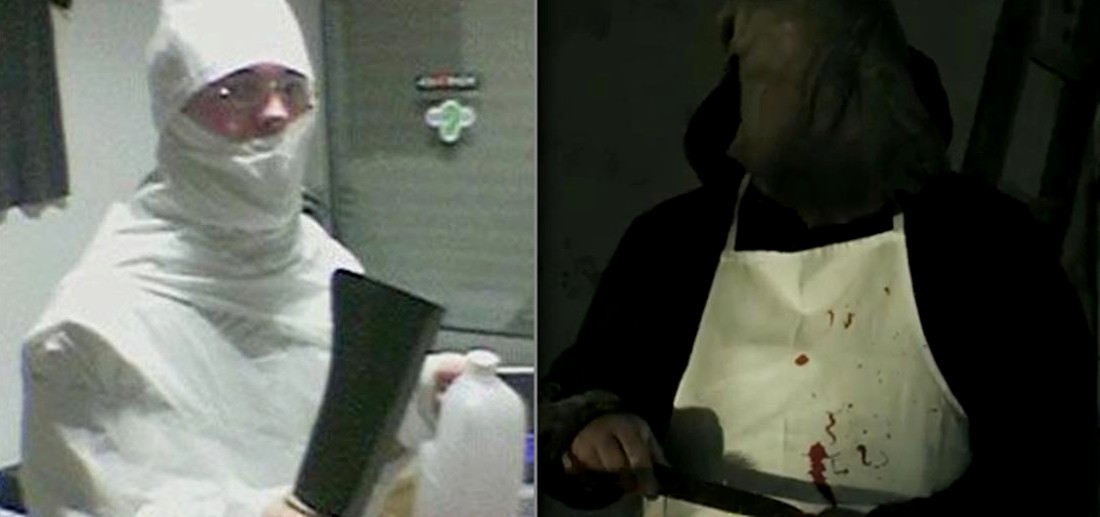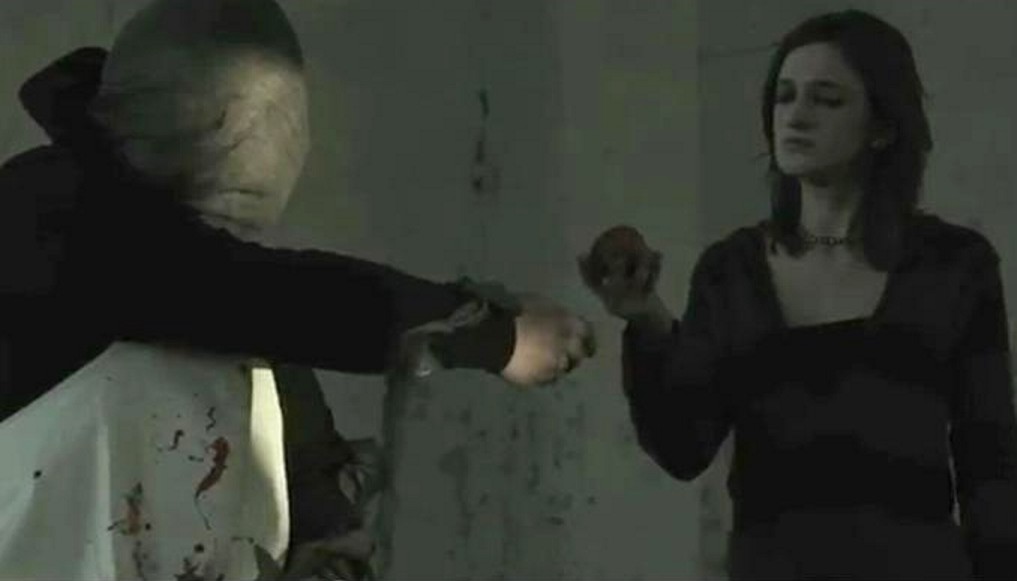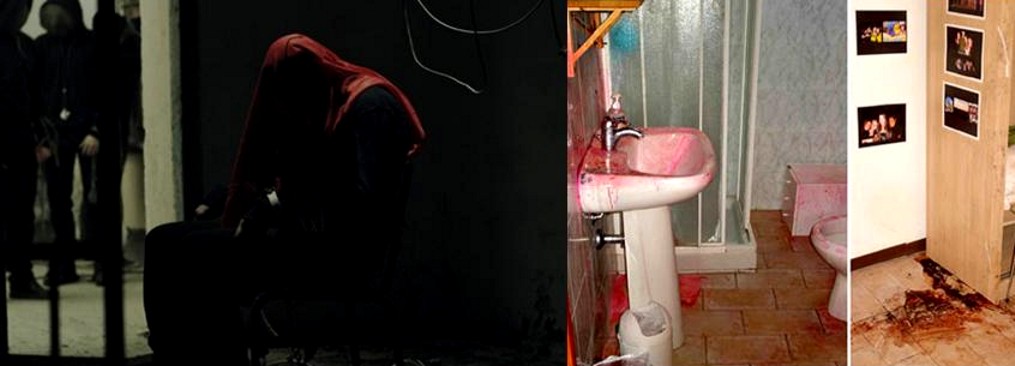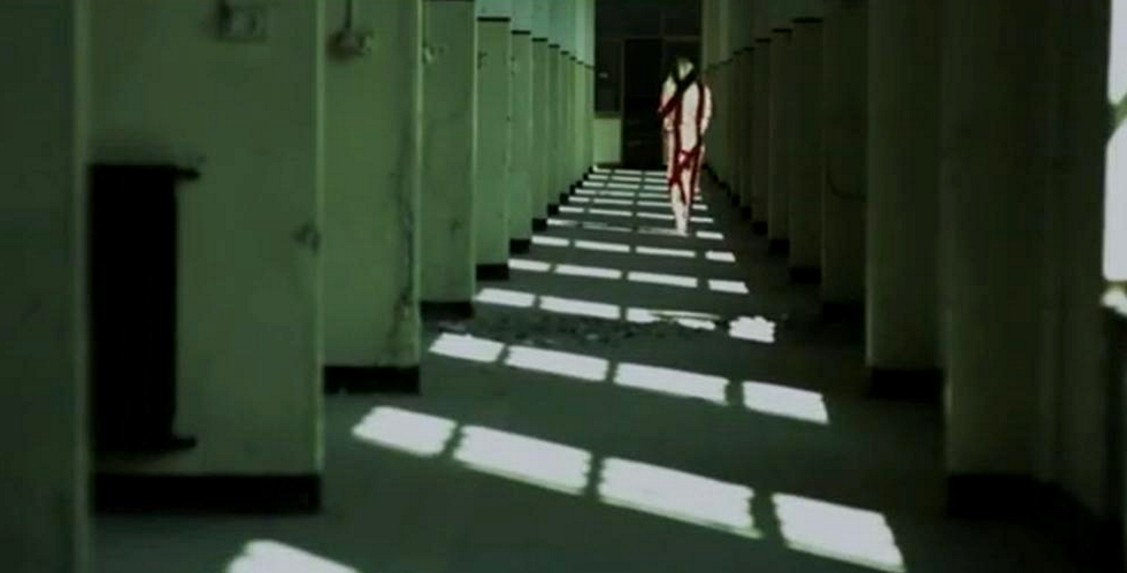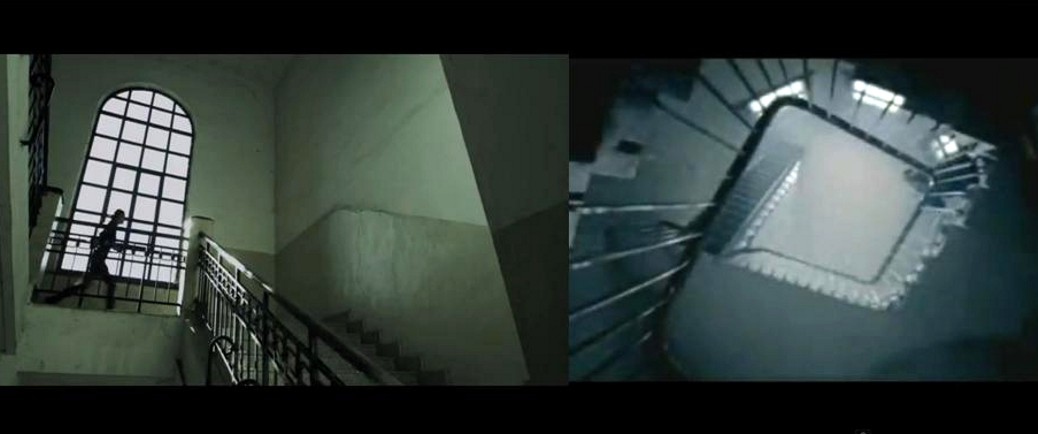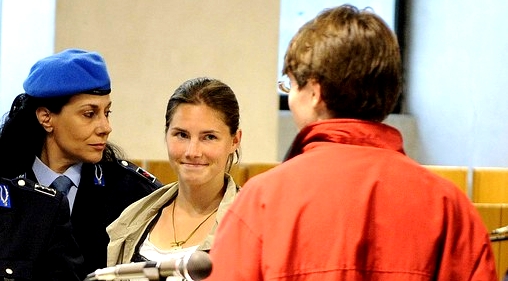
Category: The psychology
Tuesday, May 28, 2013
Demonizations By Knox: Knox Lacks Hard Proof; Sparks Widespread Anger & Contempt
Posted by Miriam

[Header of the Giallo article; the rest off it is at bottom; click for a larger image]
1. The Fake Knox In Her Demonizing Book
Amanda Knox may have felt she was “waiting to be heard” in America but here in Italy we have heard her many times, and we feel we know her pretty well.
Her book and interviews don’t sound like her at all. They sound like nasty legal stunts and nasty PR at work. It is easy to disprove her disparagement of officials and her friends here, and an investigation by the Chief Prosecutor in Bergamo is already under way.
So the big question for us here is not angrily “Who are these appalling police, prosecutor and prison officials, and why did they do these terrible thing?” but sadly “Why was she compelled to invent all this stuff?” and “Why is she so scared to come back?”
2. The Amanda Knox That We In Italy Know
I have translated six of her letters from prison just published in the crime magazine Giallo plus the introduction and the graphologist’s analysis. This is more like the Amanda Knox we know, not the invented one in the book.
1. The Giallo magazine’s Introductory framing of Knox’s letter below
Amanda: “Here In Prison Things Are Okay”
So writes Knox to a friend while she was a prisoner in Perugia. [The true crime magazine] Giallo publishes her letters, and then has them commented on by a graphologist and a psychologist
The letters you see published on these pages are from Amanda Knox, the young American accused, along with her ex boyfriend Raffaele Sollecito, of the murder of the British student Meredith Kercher, that took place in Perugia the 1st of Nov. 2007.
Knox, 26 years old, was acquitted in appeal, but now Cassazione has decided that the appeal must be redone. While waiting for this complicated judicial process to restart, Amanda lives in Seattle, and is traveling around America to launch her new book Waiting to be Heard for which she was paid several million euro by her publisher.
To the American television interviewers, the young American woman has said she is scared of coming back to Italy, because our prisons are terrible places, where she was threatened, molested sexually, and humiliated.
Well, in the letters that Giallo publishes in an exclusive, Amanda writes to a social worker, Maurizio, who helped her, and she seems neither desperate or scared, she has friends and cellmates with which to share many interests, From reading to music, up to manicures. There is a priest, Don Saulo, with which she talks, and confesses, and helps her in her moments of discouragement.
Sure, she suffers from the distance from her family, her loneliness and her imprisonment, but she can see her parents and speak with them frequently, and this notably relieves her suffering.
2. Six letters from Knox to the social worker Maurizio 2008-2010
April 3 2008
Dear Maurizio,
Thank you very much for that letter that for me is very interesting. I was thinking: “Why am I here?”, “why can’t I be with my mother?”, ” Yes the police can think badly about me, and meanwhile I do understand that I have to be in control, not run away from the situation, but why prison? I am 20 years old, never committed a crime, it is senseless. How can they say that I have to stay in prison like the people that can be a danger to others? Above all when they don’t know the truth?
It really is a torture and now I understand the motivation. I understand the motivation, but I do not agree. “Sweet” or not it is a “TORTURE”. I am being tortured and it is not right…...
Sorry. As I said I do suffer a lot in prison. Generally I am scared, alone, with no hope, sad, and tired, even if I am innocent.
Thank you for the article. It is interesting to know how people that do not undergo this torture as I and hundreds others think. To tell you the truth, I can’t understand how some judges can sleep at night, when they very well know that it can be a grave mistake. ah… mamma mia….
Come on! It is O.K. here. I am studying a lot and have started reading Italian Poetry.
Another thing that I like a lot is the song “A te” by Jovanotti. “perché tu sei…semplicemente sei….sostanza dei giorni miei…sostanza dei giorni miei…. (lyric of the song n.d.r.). Have you heard it? According to me it is a live song. It is true. Simple and strong. I like it a lot.
How are you? Do you like the change of weather? I spend more time outside reading a book and singing (I am still alone when I go outside). I am sun tanning but I’m still white white!
Hope you are OK. Love, Amanda
P.S. Let it be! Here comes the sun! I know that I am not alone, even when I am alone
April 28 2008
Dear Maurizo,
Thanks again for your thoughts and your gifts.
I really like the T-shirts and the book of art. Beautiful! Mamma mia the talent of the artists always surprises me! Thanks. But you know, you do not have to buy me anything. I am happy just to hear from you.
Really, [Priest] Don Saulo speaks to me so much about God’s gifts, especially about the strength to overcome the difficult moments, of which there are so many. He bought me a book on philosophy entitled “Umanesimo Integrale” and we speak often of my thoughts and my questions. He is a true friend and a very good man.
It’s true, I must start to read a bit of classic Italian texts. Maybe there are some books in the library for me….......Who can explain to me about “Divina Commedia”? I know it exists and that it is famous, but more than that I am ignorant, unfortunately.
Now my father is here with me, but he has to return to the United States, next week. In his place the husband of my mother, will come. I am happy, because from him I receive a lot of strength. He is like that.
Today I go to the gym course (in a bit) and I have a home telephone call. My first telephone call was last week and I was so excited. The voices of the people I love are really a gift. I trembled a bit after those so little ten minutes.
Now, I must go to the course to sweat a bit. 😊 I hope you are very well. Thanks again for your words.You are very kind.
A hug, Amanda 😊
P.S. Let it be! Here comes the sun! I know I am not alone, even when I’m alone.
November 26 2009
Caro Maurizio,
Ciao, my friend. How are you? It’s from forever that I write you. I imagine that you must have basketball in your head, since it is the season’s sport. I send best wishes to your nephews, who play it. I am terrible at basket. I have very small hands, therefore I can’t control the ball.
I would like to thank you for meeting with my family. Chris told me nice things about your encounter, he was impressed by your generosity. I know that it is always nice and unique, every time that somebody comes toward you and they like you, just like that. Therefore, thank you, for having welcomed him, me and my dear ones.
Nearly, nearly there. O mamma mia, one has to remain strong in these days. I am always hoping so much, even if, in my stomach I feel sick, anxious. More than anything, the closer it gets, the more I have to reinforce my patience against the fatigue and frustration. But I will make it.
A lot of my family will come tomorrow to be in court. There will be my father, my mother, my stepmother and my aunt. My three sisters will be here on Dec. 2. I hope so much to be able to go home with them, finally, this time. I see it in “my third eye” the vision of being on the plane between my mother and my sister. Maybe, I am thinking to much about it.
Anyway, I hope you are well. I must go to sleep early tonight, to be ready for tomorrow.
Thank you for your continued support.
Your friend, Amanda 😊
Here comes the sun! Let it be! I know that I am not alone even when I am alone,
Happy Thanksgiving!
April 20 2010
MAURIZIO
Hi! How are you? I’m happy that I made you happy with the full translation. For me it was a satisfying job, so I thank you too for the chance that you gave me. I don’t think it will be a bad thing put up my name as a translator. OK it is fine for me and yes if you like it, you can even put my second name Marie,
Thank you very much for the towels, to be truthful I really needed them. They are beautiful. I gave one of my pillow cases to the other inmate so we have twin pillows. She thanks you too and sends her best wishes.
Seems like that the weather is finally changing. With great pleasure I was able to wear a skirt in these days. Now people are out and we play volleyball together under the sun. I made friends with a new 19 years old girl: she is an athlete too. Every day we walk or play with the ball together,
Next Friday my mother, father and stepfather will be here for a visit. Mi mother and father are here for a short time to be interviewed on TV at “Quarto Grado” and then will come here. Can’t wait to see them, I miss them with all my heart.
Well, hope that you are fine. Thank you again for everything and salute you with all my affection
Hi your friend, Amanda
I know that I am not alone even when I am alone
August, 30 2010
Dearest Maurizio
Hi dear, how are you? Do you know that yesterday I was taking with D…. about you, only because you are a very special person in this world, for all that you do for others. She told me that you got married. Congratulations! Now I have to tell to my grandmother and break her heart! 😊 Just joking!
I am well enough here. I thank you again for the shorts and shirt that you send me. They were perfect as always. Thanks and I hope that you didn’t lighten your wallet too much. I am kind of disappointed that you spend your money on me, you are too generous. I am always the same here.
Just finished reading a book by Umberto Eco book that I liked a lot. In Italian should be ” L’isola del giorno prima”, I read it in English “The island of the day before”; maybe the “island of yesterday”? Anyway, I was favorably moved by Eco’s organization in this novel in order to communicate so many ideas on science, philosophy, ethic, imagination, literature. It was a book very rich on thoughts, and colpi di scena during it’s path.
I like Umberto Eco because he meticulously builds the story that he wants to tell. Of all he writes, nothing is taken for granted and this is remarkable, he has a fantastic mind to dig deep while following a long track. I saw a Sean Connery movie based on a book of his “Il nome della Rosa?” It was fantastic. Always meticulously built, deep and fascinating.
Seems like that the newspapers know before us when the appeal proceeding will take place. We still have not been officially notified, but my lawyers told me that it should start Nov. 24th; that in the USA is Thanksgiving Day. Hope that it is a good omen even if there is a lot in my life for which I should be grateful: to be alive, having the family that I have etc…
[Undated letter]
Dearest Maurizio,
I am happy to hear from you again. I use now the paper you sent me to answer you. Sorry to make you wait. My mother has returned to the United States nearly a week ago, and my father returns to Italy tomorrow, to see me Tuesday.
I am happy to remain in Perugia. I do not want to restart everything in another place. Also I? (blurred) have heard that the prisons in Rome are harsher than here. Who knows?
I only know that at least I know some of the prison officers fairly well, after all this time. I would be sorry to leave Don Saulo. I feel fine in my new cell. I changed it so I could be with a girl my own age. We joke, cook, we do manicures. Further, she does a manicure for me, because I do not know how to do one. We listen to music a lot because she has a radio.
Thank you for all you do for me. The paper, your words of confidence, your prayers. To Don Saulo I will send your greetings. Do you write often to him too? I hope all is very well with you. I send you a big hug. Ciao! Thank you!
Amanda Knox 😊
Let it be, Let it be! Here comes the sun! (drawing of a sun)
3. Comments by educational psychologist and graphologist Evi Crotti
Looking at the Amanda Knox letters it is evident right away how organized and precise she is: she has a perfect handwriting, elegant and without smudges. We try to interpret it with the help of the graphologist and educational psychologist Evi Crotti.
She explains: Her perfect, organized handwriting, without margins and few spaces indicates that we have before us a girl that is decisive, strong, who wants to dominate, and knows she can succeed in life. She puts herself In the center and leaves no place for others. Amanda displays a way of writing that is typically northamerican, in small print, called script.
The handwriting, elegant, big and curved, reveals an extroverted personality, and with a notable sense of taste. Her language is fluid and polished, and the accuracy with which she writes, tells us that this young girl has a need to maximize and nurse her image, to the point of becoming narcissistic: after her signature she draws herself with a smiling face.
Amanda leaves no space between the lines: this signifies an element of interior loneliness, which she attempts to compensate at any cost with approaches of verbal intrusiveness. This tells us that that her strong narcissistic behavior can escape control and lead her to present unstable behaviors. The fact instead that her handwriting is always in horizontal lines, without blurs, gives testimony to her practical intelligence and her strong tenaciousness, that allow her to reach her goals.
Also, the handwriting is rigid and this signifies that she knows how to use words with care and determination. Evi Crotti underlines that the handwriting is static: It is a sign of a behavior that is very seductive. Attention, the need to be attractive at all costs can make her lose sight of the objectivity of judgment , taking her to a subjective vision of circumstance reality.
Conclusion: Amanda seems to be in a continuous search of approval and acceptance from those who live around her. Her egocentricity, maybe pushed unto the point of a bogus personality, demonstrates that this girl possess a highly emotional immaturity that doesn’t allows her to love in an unselfish way. The handwriting slightly slanted to the left indicates a contradiction between the need to be liked and the reactive refusal toward a feminine figure: for her, probably every woman represents a rival.
Saturday, May 04, 2013
Knox Book - What The Newly Published Writings Reveal To Professional Eyes (1)
Posted by SeekingUnderstanding

Amateurism run amoke is what the unprecedented and unwise Knox extravaganza is starting to look like.
Several TJMK posts below this one have already suggested that the book was rushed into print with very little fact-checking, with no restraint on damaging false accusations, and with no strategic legal considerations.
The same thing seems to have happened with the TV appearances.
Knox had a year and a quarter under wraps to prepare herself and yet her many exaggerated and over-emotional TV claims contradict many things SHE HERSELF has said previously.
She seems to have been rehearsed by handlers with little or no grasp of the extensive fact record.
And where has all this amateurism left her? Open to slow erosion of her credibility by an increasing number of commentators while considerably upping her peril in Italy.
Because many of her claims falsely accuse officers of the court, she could be further indicted for contempt of court, and she could see the five years which was lopped off her sentence by Judge Massei for “mitigating circumstances” reinstated.
Those of us with psychology credentials may not have all been expecting the same thing from Knox when she finally surfaced. But none of us expected to be confronted so forcefully with a classic case of a personality in turmoil.
My first impression after getting through to the end of the book was that it shows such serious disturbance psychologically, so much being revealed in her own words.
It wouldn’t be possible to classify AK as clinically insane, the niceties of this being so precise - but an abnormal mind is clearly illustrated. So clear that it is actually sad - that she has been allowed and encouraged to do this.
The ghost writing, or/and her own expression is also painful to read in terms of quality of writing. These are the main points that have emerged for me, from a psychological perspective, after reading:
AK’s grip on reality (even without drugs) is tragically lacking. It seems that she doesn’t know what a ‘fact’ is. Every fact and event is seen through a lens of her own feeling or emotion - logical connection being absent - together with how she believes it is best to make it appear.
‘Her “best truth” is this over and over again. She doesn’t even understand that this is considered by normal minds to be lying. She doesn’t seem to have a concept of lying.
- “their version of reality was taking over”... Does reality only come in versions?
- “something didn’t feel right. it seemed made up”. Does she not know?
AK continually refers to herself as “different”. She is, but not for the curious or trivial things she believes. She is also obsessively concerned to be seen and classified as a “good person”. This comes up over and over.
“I didnt want them to think I was a bad person”. Note, not: “I didn’t want to BE a bad person” but always “how will people think of me”. This is a continual theme. “I couldn’t believe anyone could think that of me”.
It does show a dissociative and non-integrated personality, with both deep roots and serious implications. There are also indications that she is unable to ‘read’ people’s faces /expressions with any accuracy. (Emotion recognition).
A more sinister and disturbing facet to her personality connected to the above, which comes through in every chapter, is the automatic disparagement of anyone who displeases her (which of course happens frequently - whenever, in fact, someone has a different version to ‘her best truth’).
Someone is then ‘useless’, ‘betraying me’, ‘stupid’, etc etc. These words are all said matter-of-factly…. as if they really are facts. Here are some more of these words, peppered within the text:
- ‘Repellant, self-serving’, ‘hostile’, ‘insincere’, ‘abandoned (me)’, ‘uninterested’, ‘aggressive’, ‘spiteful’, ‘curt’, ‘disdainful’
- ‘Old perv…lecherous’, ‘glared cruelly’, ‘idiotic’, ‘insidious’, ‘controlling’, ‘condescending’, ‘mean’, ‘hateful’, ‘ruthless’....
Note that it is not that AK finds these people to be these things, in her opinion- it is that they ARE these things.
The sub-text is: I am a good person, and they, having displeased or disagreed with me, are ‘bad’. Thus the mechanism for strong, unrestrained projection is at work.
Example: “The police couldn’t bear to admit they were wrong.” Could she, though?
Her projections are so blatant, that I quake for her lack of self-awareness. I used to read literature as a window into self-awareness, insight, philosophical depths, and questions of morality.
Sadly this book is about as far from offering these as one could go. A PR machine missile is not a ‘book’ in the sense I used to know.
AK reveals a very strong inner anger, the control of which is difficult, and which it would seem she is frightened of, and frightened of revealing.
She would also seem to be based in a passive aggressive stance, which gives rise to a side seen as nice and even gentle. These two sides seem badly split.
This would be in keeping with the Envy hypothesis (I refer to Melanie Klein’s ‘Envy and Gratitude’). There are a few definite examples of the consuming anger which Amanda herself describes graphically.
She continually justifies it, also. Sometimes, of course, anger may be justified (‘just anger’) but as described here it is nearer to a rage or a tantrum when things aren’t going according to how she wants them to.
This speaks of manipulation, which would be part of the same profile, and is essentially destructive and spoiling, as well as something that wells up with a will of its own.
She often exposes her state of mind in certain phrases, without realising the implications of what she is saying. This is why I think the whole thing is so sad, as she has been used (seemingly mainly for money) in this foolish venture.
For example: “In that instant I snapped.” when the detective said “you know who killed Meredith.” It wasn’t the pressure/abuse from the police that made her snap, it was being confronted with the truth.
NOT her ‘best truth,’ but one that was simply unbearable to hear. There are many other examples, littered throughout the book, of some of her inner chaos:
- “This is my own fault. I caused the confusion”
- “I wanted to disappear. I didn’t want to be me anymore”.
- “I didn’t know if I was allowed to keep my thoughts private…”
- “Like a roller coaster ride….can’t get off. This is all my own fault” .
- ” I was furious for putting myself in this situation”.
- Rafaelle - “He didn’t look at me. I wondered if he hated me”. (Why should he?)
- “We want justice. But against who? We all want to know, but we all don’t.”
There are many others. Amanda Knox said she loved Italy and I believe her. With adjustment she could have been a lot happier there than she perhaps ever was in Seattle. Now she is in the position of demonizing Italy and its good people there, and in the worst possible way.
Italy was in fact very kind to Amanda Knox, and her treatment there was on the right lines to give her hope of enduring stability. What a pity that dirty PR and legal tricks and money grubbing may have pushed that out of sight forever.
Wednesday, February 06, 2013
Should The Knox Defense Point The Finger At An Angry Daddy?
Posted by Our Main Posters
1. State Of Judicial Process
Given a level playing field (a big if) it seems for now that Amanda Knox and Raffaele Sollecito are almost certainly going down for the final count.
There is not the slightest sign that their defense lawyers know how to contend with the Supreme Court appeal filed by Umbria’s chief prosecutor Dr Galati. One may have already walked (Maori) and the fact that the others don’t respond publicly to the Galati filing speaks volumes to Italian lawyers.
If the first appeal (called in Italy the second level) is rerun in whole or in part, Sollecito and Knox could see Judge Massei’s “mitigating factors” annulled and find themselves each facing 30 years inside or even life.
The whole thrust of Sollecito’s ill-timed book (subtitle “how to shoot oneself in both feet”) is that he deserves to serve less time than Amanda Knox (who he “nobly saved”) and preferably to serve no time at all.
2. Sliding Scales Of Discussions
Many bright people follow the case. We have many lawyers and crime experts and even judges read here. Many took a long time to settle on a “guilt” point of view and approached it very professionally (reflected in many of the posts written by professionals here). This is contrary to the klutzy, amateurish FOA campaign and their inaccurate rants about “haters”.
There are various great sliding scales or continuums in considering all aspects of this case. A lot of what we talk about on PMF and TJMK is where, precisely, we should all come down on each of these various scales at the end of the day. Especially of course how the judges in Rome and Perugia should calibrate them.
Via Dr Galati’s appeal and especially Sollecito’s book, we now have a new one. If reconvicted, should Sollecito and Knox serve equal time? Or should one or other serve more? Let us approach this by considering first some of the most-discussed of the sliding scales.
1) Was Knox a good friend of Meredith or increasingly a pariah?
Many here incline strongly to pariah.
Knox has an obvious tin ear and sharp elbows, was doing little study in Perugia, was making life hell for all her flatmates, was bringing noisy threatening lowlife men home (the other three virtually never brought men home), was disturbing Meredith’s studies, was hitting on patrons in Patrick’s bar, and was definitely into drugs to the extent that she might already have become an addict.
2) Pre-meditated murder or a hazing or spontaneous spiral initiated by Guede?
At least some here incline to the view espoused by some psychologists that Knox and Sollecito were probably both at minimum fantasizing violence, Knox against Meredith, and Sollecito long-term generically.
Knox had become threatened by Meredith in several different ways: Meredith was prettier, was much funnier, had won the best available boy, was brighter, had a tougher study regime, was more directed and ambitious, and had left Knox in the dust on all fronts. Hints that Meredith was about to get Knox’s job at Patrick’s bar could have been the last straw.
To most here, Knox has always seemed the initiator and the leader in the rage against Meredith, and the other two were possibly drawn in by group dynamics.
Judge Micheli certainly believed this. Judge Massei might have done, and his pointing at Guede (espoused in spades by Hellmann and Zanetti) and Massei’s “mitigating factors” both seemed “humane” stretches to give them a few years off - stretches which Chief Prosecutor Galati in his appeal and the Supreme Court in their finding on Guede have already both rejected.
3) Isolated crime/unique family or does American society incline this way?
Statistics show that society here in the US is separated out between super-rich and the other 99% more than at any time in the past 80 years and although productivity has been going up amazingly, all fruits of growth have gone to those super-rich. Many of them have a mindset that basically tells them they made it on their own, and government roles in their success and that of their creative hard-working employees dont matter a damn.
The situation and the anger in the US has been worsening, and absence of true growth for most people also have European and Japanese societies in disarray
In the US one can see heightened levels of anger in the losers of the Superbowl, in the renewed buying of guns, in conspiracy theories on the Internet, in the success of the very thought-provoking Hunger Games books and movie (small people against rich and a captured, cruel over-militarized government), in politics (of course!), and in the vitriolic flames on the IMDB movie forums now against the front-runner movies and actors for the Oscars.
We may not see this at major play here in the crime against Meredith, though, except in the over-competition sense, and the sense that Knox grew up in slight poverty (see below) and was burning through her savings with all the cocaine use (Perugia cops think it was cocaine)
4) Mental ill health in the perps and/or families or original evil?
Sollecito’s dad has long admitted that Raffaele is not normal, and he has struggled to keep him off drugs and focussed hard on his studies. His dad also admitted to all Italy that Sollecito included defamatory lies in his book.
An open and shut case? Seems so. Raffaele now looks “uncomplicatedly” psychopathic and the myriad wrong and nasty claims in his chest-beating book really hammer this take on him home.
That book seems to be his equivalent of Knox’s abrasive, uncaring two days on the stand in 2009 which so damaged her with the Massei jury.
Knox’s mental health seems more complicated. She was widely known to be “quirky” as a kid and then she became pretty wild in Seattle after she moved to live near the university. That certainly wouldn’t have helped.
Most recently, Knox seems to be sliding away into a bubble world without any possibility of admitting she needs treatment, which seems to explain her being kept well out of sight for a year now and not working or studying.
Generally the PROSECUTION in Perugia has been the side to suggest she is not mentally fully well (after the psychological tests in Capanne Prison in 2008) and the DEFENSE and FAMILY has been the side that shrugs this off and hasn’t made it any part of her defence.
Knox seems to have given off plenty of signs in the days after Meredith died that she was alternating between glee and horror. So she seemingly did know what she was doing on the night, and our guess is that it was she who pushed the knife in. In these circumstances the original verdict and sentence seem appropriate.
However!
5) Knox made herself what she was or did her family contribute?
Curt Knox’s seeming blind rage at Edda during their marriage and for years after are an open secret among some in Seattle. He apparently had one of the worst records in the entire US in not paying child support to Edda for Amanda and Deanna, and had again and again to be taken to Superior Court by Edda to be forced to make his monthly payments.
Here are two public records showing two instances of him being taken to Superior Court by Edda.
And we are told that Curt Knox was counseled by one or more judges to get himself some anger management therapy. Apparently he wasn’t formally required to take anger management therapy. He may have done so, though there seems no record that he ever did.
Okay. Not all kids growing up in such toxic family situations suffer, but some do, and a few end up with their hard wiring seriously messed up. Some even end up as drug-takers and murderers.
The classic example recently was the mass killer Anders Breivek in Norway, whose early childhood in a toxic family situation was not entirely unlike Knox’s. (In that case also, the prosecution thought maybe he was nuts, and the defense, successfully, argued otherwise.)
Italian lawyers tell us that it would be for the DEFENSE to bring this up in Perugia if it is a possible mitigating factor, and that it doesnt impinge on the prosecution’s case.
But how could they?
Curt Knox was apparently the one who shushed Amanda Knox at their first meeting in Capanne Prison, Curt Knox was apparently the one who misled her about the world-wide skepticisim against her (she didnt know about that until she came out of prison), and Curt Knox was apparently the one who drove the nasty PR bus - and most recently hosted all of the worst of the rabid PR nuts (including Sforza and Fischer) in Seattle.
Curt Knox has apparently consistently instructed the defense lawyers and PR honchos to keep the pedal to the floor, even though Chris Mellas once openly argued against that. Amanda Knox may have pushed the knife in, but Curt Knox for five years has not come clean about his own possible role in any mental condition.
Our present conclusion
Without a lot more information on Amanda Knox’s early days in her broken home in Seattle, and her current mental condition and condition back in 2007, it is pretty hard to calibrate this. It is not really possible to be precise about where she should be on any sliding scale of time deserved in prison if she is finally convicted.
It is really incumbent upon the defense counsel in Italy (their lawyers’ code of ethics requires this) to push hard for this information, and if they think it relevant to present it to court at any rerun of the appeal trial.
Amanda Knox herself should want this.
Wednesday, July 04, 2012
The Hands Of Time Video With Screenplay By Amanda Knox - A Confessional Obsession?
Posted by Fly By Night & Thundering
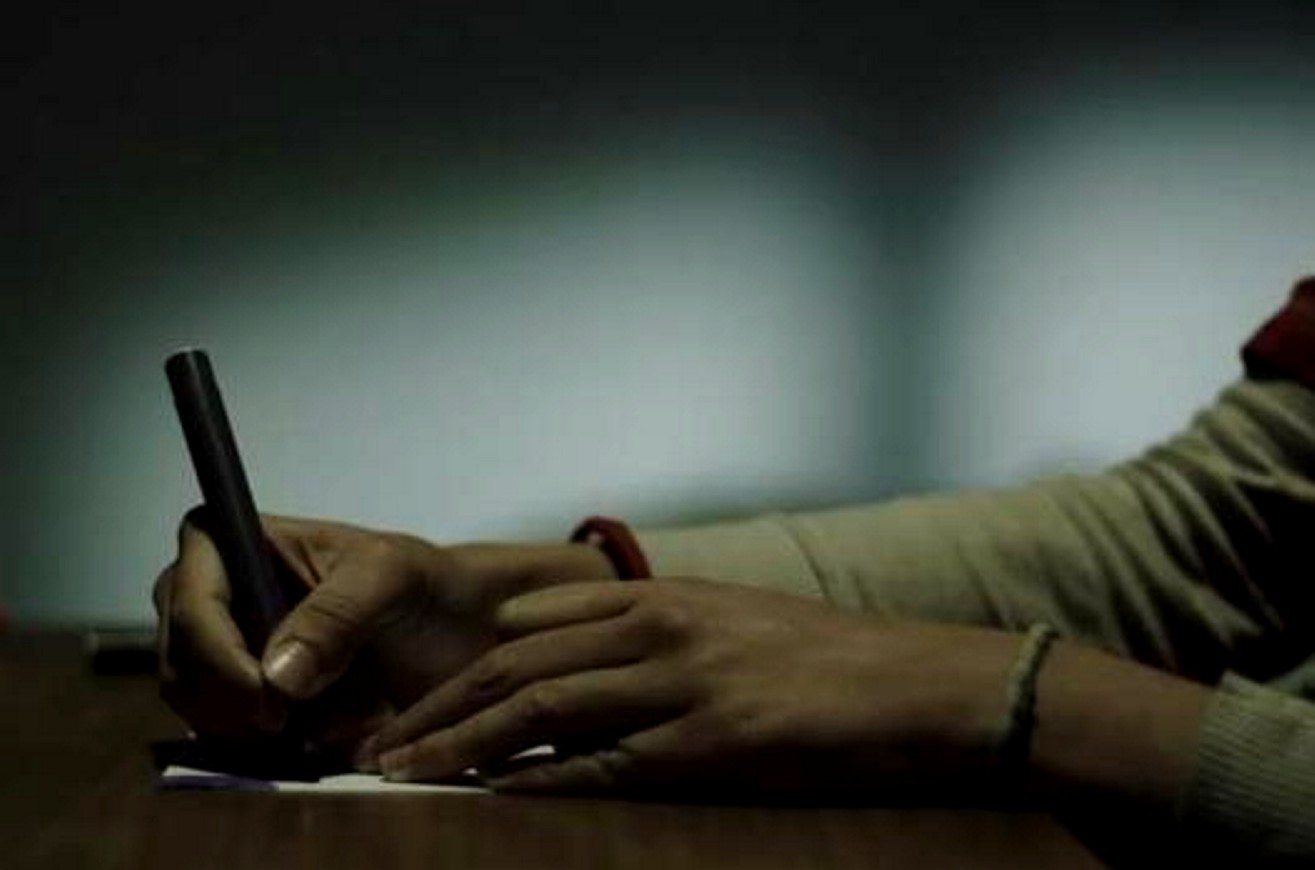
Amanda Knox rarely, if ever, mentions her “˜close friend’, murder victim Meredith Kercher. Perhaps out of her self-proclaimed desire to “˜move on with her life’.
So the recent Hands of Time (H.O.T.) music video The Mistral Blows which was posted on YouTube with a screenplay attributed to the Seattle native is nothing if not astonishing.
Whilst there is some discussion as to whether Amanda Knox wrote the entire screenplay, or a section of it, or whether the screenplay was created through a merging of several versions, the screenplay is clearly attributed to her in the credits that appear on the video.
Crediting Amanda Knox with the screenplay is repeatedly emphasized by H.O.T. themselves who posted multiple Twitter entries:
And this screenplay does Amanda Knox and her claims of innocence in the brutal murder of Meredith Kercher no favours at all.
Although provisionally “˜acquitted’ at the trial of second instance, Amanda Knox still stands accused of a capital crime, aspects of which she seems compelled to continue to portray in her various writings.
The hapless band H.O.T. might be well-advised to disassociate themselves from this endeavour and drop the video like a hot potato. The more-so as they have already burnt their fingers, tampering with the so-far elusive Brand Knox, finding themselves “˜forced to remove [clips of Knox dancing in Capanne] from the file, after a sudden, unexpected and “very strange” last-minute opposition from Amanda’s entourage.’
They state with a hint of bitterness:
The result? A compromise. The image of Knox dancing with carefree abandon in Capanne Prison (easily retrieved from other internet sites) remains, but is obliterated by a large “˜censored’ notice.
The reasons to attempt to disappear this video or, at the very least, any identifiable links with Knox, are abundantly clear to anyone having followed this dreadful case over the last four and a half years.
1) The video is riddled with allusions to the crime itself and features an easily-identifiable Amanda Knox as “˜heroine’ or “˜victim’ as she may now prefer to be seen and depending on how you look at it.
2) Any pre-book-release publicity will potentially devalue the carefully branded and preserved Amanda Knox product.
A cursory look at the video demonstrates the depraved audacity of the writer, a person who simultaneously insists she was found innocent of the crime of murder and of which she still stands accused.
The video features a Knox look-alike ““ recognizable by her clothing - in a prison-cum-house of horrors.
It opens with the heroine sitting down, colouring pictures in a prison cell. Amanda Knox was reported to spend time colouring pictures of her hands whilst in prison.
From there she leaves the cell and embarks on a journey through a range of horrifying experiences, until she finally flees the house but not the prison to which she is eternally condemned.
As she runs through the house of horrors she encounters:
1) Ghost-like figures lurching out at her hinting at the night of Halloween before the murder and the ghouls and demons of the house of horrors both in which the crime took place and in which she is forever imprisoned.
2) A tall, faceless black-haired figure dressed in black carrying an umbrella resembling Meredith Kercher dressed as a vampire on her last night alive, the red belt reminiscent of the fake costume blood and the actual blood spilled the night of the murder.
3) A faceless butcher figure dressed in a blood-stained apron holding a knife, who hands her a maggot-infested apple, reminiscent of the photograph of co-accused Raffaele Sollecito as posted on his Facebook page. The apple is suggestive of the poisoned apple offered by the witch to the innocent Snow White ““
4) Or a subliminal suggestion of Raffaele’s guilt in handing her the infested and poisonous apple “¦.. Remember: she claimed Raffaele may have pressed the murder knife with Meredith’s DNA into her hand whilst she was sleeping.
5) A figure tied to a chair covered in a red cloth hinting of the pools of blood and of Meredith unable to move to defend herself. As she reaches out to lift the red cloth the bound figure screams, sending her running out down staircases and steps and out of the house.
In the same way, witness Nora Cappezzali heard Meredith’s desperate, blood-curdling scream, followed shortly afterwards by running footsteps out of the house of horrors and onto the steel staircase near her home.
The video ends with the Knox look-alike remaining in prison. Both real and imagined.
H.O.T. suggest that the video and screenplay are a means of documenting the tale of the events in Perugia and, of course, Amanda Knox hopes to chronicle the nightmare in which she “˜innocently’ found herself. In so doing, she inadvertently describes the crime and the images, sounds and memories that will seemingly not leave her alone.
Not only are there many references to the crime, but there seems as well a clear jealous obsession with Meredith, given the numerous references and comparisons to Kristian Leontiou’s video Some Say in which Meredith hauntingly starred.
The Knox look-alike emulates Meredith from the Some Say video both in her dress and appearance as well as in her actions. She descends an old staircase, appears in doorways and through arches reminding us of the shots of Meredith and the church of the “˜Some Say’ video.
Emulation is a form of envy. Guilty or innocent, it seems Knox cannot exorcise her memories of the crime, and remains compelled to depict it in screenplays and short stories. Knox is seemingly still jealous of Meredith which had proved her original undoing. Here, in a bizarre reversal of reality, Meredith becomes the foreboding, frightening presence, whereas Knox is the shocked and terrified victim.
At a time when a tough Galati appeal to the Supreme Court and a $4 million book deal are on the table, the memory of Meredith and the crime seem to haunt and obsess Amanda Knox who may reveal a deep-seated need to confess. But while still accused, Amanda Knox cannot afford to engage in such obsessive, confessional activity.
Could this prove to be her final undoing?
Wednesday, September 28, 2011
Pseudoinnocence: Is This Possibly The Predicament Of Amanda Knox?
Posted by Vivianna
In a dissertation titled Pseudoinnocence ““ An Invitation To Murder, Barbara Shore explores the phenomenon of “pseudoinnocence” in American culture as an inadequate response to the “conflagration of violence that encircles us today.” These are her introductory words:
“America is a country long haunted by its pseudoinnocence, by its blinding prolonged naivete. We are a culture that closes our eyes to all that is too painful to see, persuading ourselves that we have escaped, that we are neither interdependent nor vulnerable, or that we are victims.
We cannot come to terms with our own unwitting complicity in the destructiveness brought to ourselves or others. Capitalizing on such naivete, we fail to see how such “˜innocence that cannot include the demonic becomes evil’ (Rollo May 50).” (Dissertation Abstracts International Section A: Humanities and Social Sciences Mar, 2001 Vol 61(9-A))
Ms. Shores’ words, although published six years before the murder of Meredith Kercher even took place, represent an eerily accurate description of Amanda Knox’s predicament, even reflecting some of the terminology employed in Attorney Carlo Pacelli’s exposition on September 26, during the closing portion of the first appeal trial. As a reminder, Pacelli, who represents Patrick Lumumba in his civil suit against Knox, pointed out that Knox “has a split personality, fresh-faced, the daughter everyone would like, Saint Maria Goretti, and then with her histrionic side [she is] an impostor, she is a she-devil, satanic, diabolic, addicted to borderline behaviour.”
Although Pacelli’s words have been seen by some as too harsh, they carry a heavy implication mirrored in the above quote from Shore ““ that “innocence that cannot include the demonic becomes evil”; in other words, that if Knox cannot reconcile her two sides and seek atonement, she has no hope of redeeming herself as a human being.
I have argued before, in a comment posted here on the TJMK board, that Knox is not likely to make a confession in the near future due to the pressures exerted by her family’s innocence campaign. The innocence campaign is, in my opinion, just one of the factors which prevent Knox from admitting her direct involvement in the crime against Meredith Kercher.
The other factors may include her failure to reconcile the two parts of her persona (innocent, carefree, kind, compassionate young woman versus “diabolical” murderer) and perhaps a culturally-engrained inability to accept involvement in a destructive act. The discussion of these latter factors is perhaps best left to someone with formal training in psychology or sociology. What I would like to enlarge upon is my conviction that there is a direct correlation between the strength of the innocence campaign and Knox’s unwillingness to admit guilt.
I would like to draw your attention to a conversation between Knox, her mother (Edda Mellas), and her father (Curt Knox) which took place in the early days of the investigation, when Amanda had already been detained. This conversation will be well-known to those who have been consistently following this case as evidence that, in the early stages, Knox may have been inclined to give a confession. I have chosen not to include it, but it is readily available on both TJMK and PMF.
The reason why I believe this conversation to be so important is not only because it might contain the beginning of the confession, but also because it highlights the involvement of her family in defining her position. I would argue that, had Knox been left to her own devices, she might have cracked in the early stages and given an accurate description of that night’s events, saving both herself, her family, the victim’s family, and anyone involved in the trial considerable grief, time, money, and effort.
At that particular point in time, she may not have been as psychologically divided and conflicted, and she may have had an easier time accepting her criminal side and perhaps moving on to experience positive changes. It is, however, her parents’ firm belief in her innocence and in her inability to commit such a heinous crime that has consistently mired her in a difficult position.
As we well know, the Knox-Mellas family hired a PR firm, Gogerty-Mariott, to clean up Amanda’s image after unflattering stories started appearing in European tabloids. The PR campaign has grown exponentially from a few stories about Amanda’s childhood, complete with baby pictures, to what I consider to be a falsification of public opinion.
On the one hand, there is a concerted effort to offer inaccurate information about existing evidence (limiting the crime scene to Meredith’s room, stating that there is no evidence linking Amanda and Raffaele to the murder, pushing Rudy Guede as the “lone wolf” assassin, etc.), which is then fed to news outlets unwilling to do their own research and pushed upon the unsuspecting public via books, blogs, and forums. Then comes the even more insidious effort to falsify the public’s response to these stories, by hiring posters to write positive reviews for FOA books, post positive comments to inaccurate stories, and shout down any reasonable opposition.
Of course, this entire effort does not come cheaply, and rumors say that the PR campaign’s tab is around one million. This is an enormous debt to place on the shoulders of a young woman who already needs to contend with the guilt of having committed an incomprehensible, heinous, violent crime. While it is difficult to feel sympathy for any of Meredith’s killers, I find it impossible not to feel a certain amount of compassion for Amanda, who most likely never asked for this campaign to be initiated. How could she admit her role in this crime when a million dollars has already been spent to trumpet her innocence?
In addition to the material aspects, there are social and psychological aspects to contend with. While many of the FOA members are paid for their public appearances and statements (and may not harbor any personal opinions about the case), there seem to be individuals who are supporting Amanda’s innocence out of personal conviction. Some of them may have even donated money to help her family. How could she disappoint everyone who invested money and time into supporting her, from her own family to charitable strangers? How could she look them in the eye, after four years of lies and obfuscation, and admit that she was terrified of being punished, or incapable of seeing herself as a murderer?
Peter Quennell has suggested to me that this may be an example of “path dependence,” a concept used in both economics and social sciences to describe a scenario in which current actions and decisions are inexorably determined by past decisions. While my personal knowledge of path dependence is limited, I think that it is certainly applicable in this case and that it can be traced back to the prison conversation discussed before. During the conversation, Amanda’s parents indirectly communicated to her that the course had been set ““ that the legal team would handle all questions and that she was not to communicate her thoughts without supervision; also that a confession would be unacceptable because she was undeniably innocent.
As to why her family took this position, I think we can find the answer in the concept of pseudoinnocence ““ the inability to accept responsibility for and involvement in a terrible event, accompanied by a forced distancing from anything that could be considered troubling.
It is not a coincidence that Amanda has been consistently portrayed as a victim of the supposedly corrupt, medieval Italian justice system, as someone who has been “railroaded” in a “third-world” country, as her supporters want us to believe. It is more comforting to become a victim than to accept responsibility and acknowledge that Amanda’s problems may have started at home, long before she was on a plane for Perugia. I believe that the innocence campaign is not only meant to exculpate Amanda, but to also exculpate her family from any perceived contributions to the formation of a murderer.
As long as Amanda’s family continues to invest so much money and effort into supporting her innocence, and to maintain so much publicity around her case, I believe that any professional attempts to help Amanda admit her involvement will prove ineffective. This entire undertaking, combined with her own psychological dividedness and any cultural influences, is placing an enormous amount of unnecessary responsibility on Amanda and displacing a more appropriate type of responsibility.
Amanda, at this point, should feel responsibility towards Meredith and Meredith’s family primarily. While the murder itself cannot be reversed and no true solace offered, a confession would offer a certain amount of closure to those who knew and loved Meredith. Instead, Amanda’s sense of responsibility is being artificially redirected to not disappointing her own family and supporters, and to not betraying the trust they have placed in her innocence. Aside from being hurtful to the victim’s family, this situation is also damaging for Amanda herself, as it’s setting her on a path of continued “evil” rather than one of heal
Wednesday, September 14, 2011
A New Book Explains The Unfruitful Emergence Of More And More Conspiracy Theories
Posted by Peter Quennell
Conspiracy theorists have dismally failed to come up with a plausible alternative theory of how Meredith died.
However, they do keep trying. So do the proponents of literally hundreds of other conspiracy theories, constituting vast amounts of effort probably better spent elsewhere - conspiracy theorists very rarely achieve very much, or do well economically, or rise to the top jobs.
The articles here and here look with skepticism on the 9/11 conspiracy theories which on the tenth anniversary of the twin towers coming down have been pushed hard by the various factions.
Now a new book “The Believing Brain” explains the mental makeup that disposes people to so eagerly believe the worst of our fellow man or our governments: One review in the Wall Street Journal..
In Mr. Shermer’s view, the brain is a belief engine, predisposed to see patterns where none exist and to attribute them to knowing agents rather than to chance””the better to make sense of the world. Then, having formed a belief, each of us tends to seek out evidence that confirms it, thus reinforcing the belief.
This is why, on the foundation of some tiny flaw in the evidence””the supposed lack of roof holes to admit poison-gas cans in one of the Auschwitz-Birkenau gas chambers for Holocaust deniers, the expectant faces on the grassy knoll for JFK plotters, the melting point of steel for 9/11 truthers””we go on to build a great edifice of mistaken conviction….
Mr. Shermer offers a handy guide for those who are confused. Conspiracy theories are usually bunk when they are too complex, require too many people to be involved, ratchet up from small events to grand effects, assign portentous meanings to innocuous events, express strong suspicion of either governments or companies, attribute too much power to individuals or generate no further evidence as time goes by.
The increasingly shrill posts appearing daily on the website Ground Report seem to mark pretty high against that list. Could the Evil Mignini have engineered even this?
Oops. Another conspiracy theory in play.
Sunday, September 04, 2011
An Overview Of Modern Thinking On The Criminal Mind
Posted by Ergon
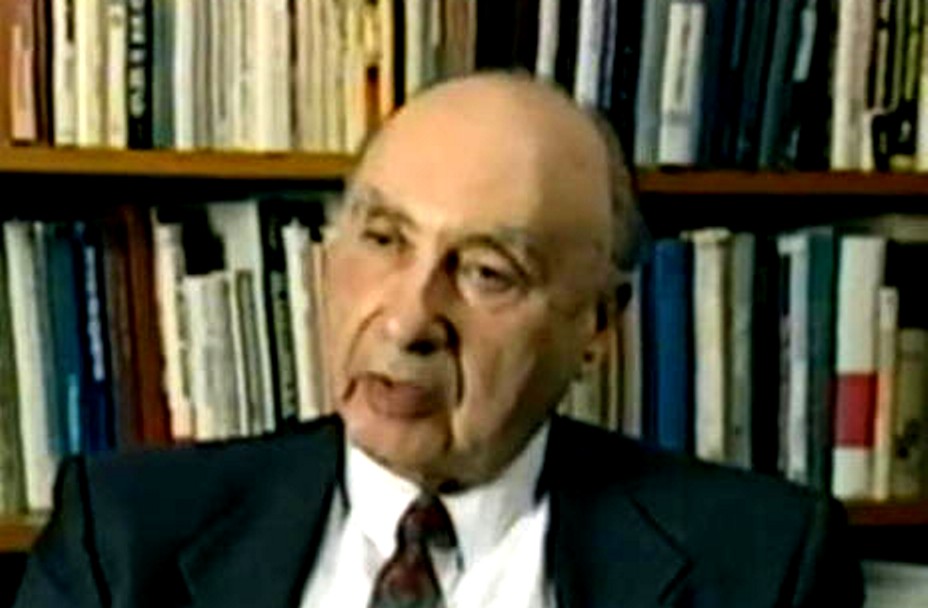
[Above: an image of the influential researcher Dr Abram Hoffer]
l
Introduction:
The question of criminality has been much in the news lately, as wild gangs of youth rampaged through British cities, and wild gangs of feral financial speculators rampaged through the world’s economies.
As a scientist I wonder about the pathologies involved, and as a spiritual person I wonder about root causes.
So this is about where we are going as a society. Are we descending into criminality, and is the problem getting worse? I also wonder about the connection between criminality and mental illness.
In the course of trying to find a treatment for my own children’s Autism, I came to the following conclusion: conventional medical science has no clue about the causes or effective treatment of mental illness.
Therefore I had to range further into alternative medicine to find solutions, and serendipitously, I did. Yet, when my son’s autism reversal was confirmed by psychologists, no one seemed to want to know how. Neither the media, nor the conventional establishment.
Never mind. My findings were presented, for free, to various alternative medical doctors and clinics, reported in journals and books, and confirmed by them. The protocol has great possibilities in the treatment of other neurological illnesses. It is possible to reverse brain disease.
At my clinic in Toronto as well as other countries, I treated hundreds of young people with Autism, ADHD, Aspergers, and other psychological disorders, using holistic medical methods alone. Many of them went on to have normal lives; most improved significantly. And, when I have the time, I will write a book about this journey, and share it with everyone.
Which I already did in fact. See here. But this is by way of background. I do not claim to have cures, or answers; I’m a searcher for knowledge, which I wish to share with others.
The question:
So: Is there such a thing as a criminal mind? This was a question much pondered as the new field of psychology came into being. In opposition to religious belief that crimes were caused by man’s original state of sin, and provoked by deadly sins like avarice and lust etc., it tried to define abnormal behaviour as a function of upbringing and environment.
It was only later as research into the nature of the brain emerged that new theories were formed; could neurological deficits explain criminal acts? Along with other suppositions of nurture and nature, addictions and abuse?
The answer:
According to these studies yes there is..
The release today of a study by the U.S. Department of Justice’s Bureau of Justice Statistics (BJS) showing than 64 percent of local jail inmates, 56 percent of state prisoners and 45 percent of federal prisoners have symptoms of serious mental illnesses is an indictment of the nation’s mental health care system. It is both a scandal and a national tragedy.
The figures are worse than those generally believed in the past, in which estimates of the total number of inmates with mental illnesses have been approximately 20 percent. The study reveals that the problem is two to three times greater than anyone imagined. What is even more disturbing is the number of these inmates that have served prior sentences, committed violent offenses, or engaged in substance abuse.
This is not an ideological statement, nor is it an attempt to avoid the serious problem of crimes in society. We have to have a system of laws and justice, and we have to protect the innocent. But the present system of crime and punishment doesn’t work, either.
So, how do we measure the criminal mind? Could there possibly be genetic, neurological, behavioral or even, physiognomic markers? I was 10 years old when a gentleman took one look at certain bumps on my head and said I “was very perceptive; could look at a scene and see what others could not"Cool, and this was my introduction to phrenology.
This was where 18-19th century researchers sought to determine racial and emotional differences through the study of skull size, shape and protuberances. And yes, they did believe the criminal’s head was different than that of normal people. This later became the field of craniology and craniometry as scientists tried to avoid making unsavory determinations.
The scars left after World War II by these atrocious programmes of research meant that the study of human skull shape and size fell into disrepute. Human variation, the core subject of anthropology, was increasingly explored through genetics and other biological markers, and became functional and adaptive in orientation rather than a search for racial affinities.
In recent years, however, the introduction of new computer-based techniques of measurement, and the greatly enhanced power of statistical analysis, has meant that there has been a resurgence of interest in this subject, and, stripped of its non-Darwinian and racist past, the study of the human head remains a topic of major importance.
So now, scientists are using cranial measurements to determine mental illness as shown here:
Recently, Harvard researchers reported that children with autism have a wide range of genetic defects, making it nearly impossible to develop a simple genetic test to identify the disorder. Now, University of Missouri researchers are studying 3-D imaging to reveal correlations in the facial features and brain structures of children with autism spectrum disorder (ASD), which will enable them to develop a formula for earlier detection of the disorder…
When you compare the faces and head shapes of children with specific types of autism to other children, it is obvious there are variations. Currently, autism diagnosis is purely behavior based and doctors use tape measurements to check for facial and brain dissimilarities. We are developing a quantitative method that will accurately measure these differences and allow for earlier, more precise detection of specific types of the disorder,” said Ye Duan, assistant computer science professor in the MU College of Engineering.
Then you have “The Criminal Brain-Understanding Biological Theories of Crime”, by author Nicole Hahn Rafter, New York University Press (October 2008)
What is the relationship between criminality and biology? Nineteenth-century phrenologists insisted that criminality was innate, a trait inherent in the offender’s brain matter. While they were eventually repudiated as pseudo-scientists and self-deluded charlatans, today the pendulum has swung back.
Both criminologists and biologists have begun to speak of a tantalizing but disturbing possibility: that criminality may be inherited as a set of genetic deficits that place one at risk for theft, violence, and sexual deviance.
If that is so, we may soon confront proposals for genetically modifying “at risk” foetuses or doctoring up criminals so their brains operate like those of law-abiding citizens.
Wow. Now this really frightens me, to see scientists, once again, barking up the wrong genetic tree, but there you go any way.
Brain Injury as a factor in crime:
Alternative physician Dr. Russell L. Blaylock: Vaccines, Depression and Neurodegeneration After Age 50
Previously, it was thought that major depression was secondary to a deficiency in certain neurotransmitters in the brain, particularly the monoamines, which include serotonin, norepinephrine and dopamine. While alterations in these important mood-related neurotransmitters is found with major depression, growing evidence indicates that the primary culprit is low-grade, chronic brain inflammation.
In addition, we now know that inflammatory cytokines can lower serotonin significantly and for long periods by a number of different mechanisms.
I would agree with him there, since it has been my observation that mental illness is often accompanied by inflammatory disorders or auto-immune illness. I also believe the changes in vaccine schedules may have led to increased neurological deficits and genetic damage passed on to subsequent generations, but that is an argument for a separate article. I do not blame vaccines alone, as I will explain here.
There is research that shows criminal minds and behavior issues are often accompanied by brain damage.
Brain injury is a condition that involves microscopic damage to brain tissue that can only be seen in life through the lens of the patterns of the injured person’s life. Chris Henry, the former NFL wide receiver whose autopsy results confirmed he was living with brain damage, may have finally made that clear.
“Limbic Abnormalities in Affective Processing by Criminal Psychopaths as Revealed by Functional Magnetic Resonance Imaging” by Kiehl, et al, (PDF)
Results: Compared with criminal nonpsychopaths and noncriminal control participants, criminal psychopaths showed significantly less affect-related activity in the amygdala/hippocampal formation, parahippocampal gyrus, ventral striatum, and in the anterior and posterior cingulate gyri. Psychopathic criminals also showed evidence of overactivation in the bilateral fronto-temporal cortex for processing affective stimuli
The brains of autistic individuals show similar defects:
The two research teams have noticed an intriguing abnormality in the brains of the small group of autistics they have examined: The cerebellum, a portion of the brain involved with muscle coordination and the regulation of incoming sensations, contains fewer neurons known as Purkinje cells. There are also preliminary indications that growth in parts of the limbic system, which oversees emotion and memory, is arrested while autistics are still in the womb
Likewise in schizophrenia and bi-polar disorder.
New research shows for the first time that both have a common genetic basis that leads people to develop one or other of the two illnesses..find that thousands of tiny genetic mutations ““ known as single nucleotide polymorphisms (SNPs) ““ are operating in raising the risk of developing the illness.
“Early Signs of Psychopathy” argues that signs can show at an early age.
A twenty-five year study, published this month in The Journal of Abnormal Psychology, demonstrates that, as early as the age of three, there are temperamental and physiological difference between those who show psychopathic tendencies as adults and those who don’t.
Not only do psychopaths lack emotions of conscience and empathy, but research has shown that these individuals consistently display certain aspects of temperament including a lack of fear, lack of inhibition and stimulus seeking behavior.
A lack of a hormone that affects empathy:
We’ve long accepted that hormones can make you amorous, aggressive, or erratic. But lately neuroscience has been abuzz with evidence that the hormone oxytocin—which also acts as a neuromodulator—can enhance at least one cognitive power: the ability to understand the gist of what others are thinking. In this week’s Mind Matters, Jennifer Bartz and Eric Hollander, two leading researchers in this area, review the many and surprising ways in which oxytocin seems to influence both our openness to others and our understanding of them.
For inherently social creatures such as humans, the ability to identify the motives, intentions, goals, desires, beliefs and feelings of others is not a nicety but an essential skill. We must understand “where others are coming from” not only to pursue our individual goals but also to facilitate social harmony more generally. Specifically, we need to recognize that other people can have thoughts, beliefs, desires and feelings that differ from our own…
And it may be this that drives psychopathy, or the criminal mind.
Cleckley in Psychopathy: Two lengthy checklists of psychopathic, or anti-social personality disorder:
Cleckley’s original list of symptoms of a psychopath:
1. Considerable superficial charm and average or above average intelligence.
2. Absence of delusions and other signs of irrational thinking
3. Absence of anxiety or other “neurotic” symptoms considerable poise, calmness, and verbal facility.
4. Unreliability, disregard for obligations no sense of responsibility, in matters of little and great import.
5. Untruthfulness and insincerity
6. Antisocial behavior which is inadequately motivated and poorly planned, seeming to stem from an inexplicable impulsiveness.
7. Inadequately motivated antisocial behavior
8. Poor judgment and failure to learn from experience
9. Pathological egocentricity. Total self-centeredness incapacity for real love and attachment.
10. General poverty of deep and lasting emotions.
11. Lack of any true insight, inability to see oneself as others do.
12. Ingratitude for any special considerations, kindness, and trust.
13. Fantastic and objectionable behavior, after drinking and sometimes even when not drinking—vulgarity, rudeness, quick mood shifts, pranks.
14. No history of genuine suicide attempts.
15. An impersonal, trivial, and poorly integrated sex life.
16. Failure to have a life plan and to live in any ordered way, unless it be one promoting self-defeat.
Hare in The Psychopathic Personality:
A psychopath can have high verbal intelligence, but they typically lack “emotional intelligence”. They can be expert in manipulating others by playing to their emotions. There is a shallow quality to the emotional aspect of their stories (i.e., how they felt, why they felt that way, or how others may have felt and why).
The lack of emotional intelligence is the first good sign you may be dealing with a psychopath. A history of criminal behavior in which they do not seem to learn from their experience, but merely think about ways to not get caught is the second best sign.
The following is a list of items based on the research of Robert Hare, Ph.D. which is derived from the “The Hare Psychopathy Checklist-Revised, .1991, Toronto: Multi-Health Systems.” These are the most highly researched and recognized characteristics of psychopathic personality and behavior”:
1. glibness/superficial charm
2. grandiose sense of self worth
3. need for stimulation/prone to boredom
4. pathological lying
5. conning/manipulative
6. lack of remorse or guilt
7. shallow emotional response
8. callous/lack of empathy
9. parasitic lifestyle
10. poor behavioral controls
11. promiscuous sexual behavior
12. early behavioral problems
13. lack of realistic long term goals
14. impulsivity
15. irresponsibility
16. failure to accept responsibility for their own actions
17. many short term relationships
18. juvenile delinquency
19. revocation of conditional release
20. criminal versatility
What is Emotional Intelligence?
Is it becoming a rare quality among young people? It certainly seems to be declining in society.
Emotional intelligence “is a type of social intelligence that involves the ability to monitor one’s own and others’ emotions, to discriminate among them, and to use the information to guide one’s thinking and actions” (Mayer & Salovey, 1993: 433). According to Salovey & Mayer (1990), EI subsumes Gardner’s inter- and intrapersonal intelligences, and involves abilities that may be categorized into five domains:
Self-awareness: Observing yourself and recognizing a feeling as it happens.
Managing emotions: Handling feelings so that they are appropriate; realizing what is behind a feeling; finding ways to handle fears and anxieties, anger, and sadness.
Motivating oneself: Channeling emotions in the service of a goal; emotional self control; delaying gratification and stifling impulses.
Empathy: Sensitivity to others’ feelings and concerns and taking their perspective; appreciating the differences in how people feel about things.
Handling relationships: Managing emotions in others; social competence and social skills.
And according to Goleman (1995: 160), “Emotional intelligence, the skills that help people harmonize, should become increasingly valued as a workplace asset in the years to come.”
The last words belong to the educators, of course.
Howard Gardner (July 11, 1943 - ) American Psychologist and Educator
Howard Gardner’s Theory of Multiple Intelligences (1983) proposes that intelligent behavior does not arise from a single unitary quality of the mind, as the g -based theories profiled on this Web site suggest, but rather that different kinds of intelligence are generated from separate metaphorical pools of mental energy.
Gardner derived this conceptualization of intelligence in part from his experiences working with members (of) extreme populations, in which certain cognitive abilities are preserved (often to a remarkable degree) even in the absence of other, very basic abilities. For example, some autistic savants display extraordinary musical or mathematical abilities despite severely impaired language development and social awareness. Likewise, individuals with localized brain damage often demonstrate severe deficits that are circumscribed to a single cognitive domain (Gardner, 1983/2003).
And Piaget, who inspired me many years ago: Jean Piaget (August 9, 1896-September 16, 1980) Swiss Biologist and Child Psychologist
Definition of Intelligence: Intelligence is an adaptation”¦To say that intelligence is a particular instance of biological adaptation is thus to suppose that it is essentially an organization and that its function is to structure the universe just as the organism structures its immediate environment” (Piaget, 1963, pp. 3-4).
Intelligence is assimilation to the extent that it incorporates all the given data of experience within its framework”¦There can be no doubt either, that mental life is also accommodation to the environment. Assimilation can never be pure because by incorporating new elements into its earlier schemata the intelligence constantly modifies the latter in order to adjust them to new elements” (Piaget, 1963, p. 6-7) (Including, imo, ‘criminal intelligence’)
Major Contributions:
The Theory of Genetic Epistemology. Piaget also believed that intellectual development occurs in four distinct stages.
The sensorimotor stage begins at birth, and lasts until the child is approximately two years old. At this stage, the child cannot form mental representations of objects that are outside his immediate view, so his intelligence develops through his motor interactions with his environment.
The preoperational stage typically lasts until the child is 6 or 7. According to Piaget, this is the stage where true “thought” emerges. Preoperational children are able to make mental representations of unseen objects, but they cannot use deductive reasoning.
The concrete operations stage follows, and lasts until the child is 11 or 12. Concrete operational children are able to use deductive reasoning, demonstrate conservation of number, and can differentiate their perspective from that of other people.
Formal operations is the final stage. Its most salient feature is the ability to think abstractly.
It is my opinion that emotional intelligence development also follows these four distinct phases. This is where nurture and nature come into play, and any trauma, abuse, neglect, that occurs during these phases can lead to an emotional stunting where the child is unable to progress to the next stage of development.
In the same way, a positive home and school environment can help children grow to be more harmonious members of society, once you adjust for any biological and neurological deficits. Early recognition and treatment is key…
Having worked as a volunteer in the public school system, I can tell you what teachers and educators have been telling me for years: the number of learning disabled and emotionally disturbed children is increasing exponentially..
Is it just me, or does it seem like the world has become an increasingly disharmonious place lately?
But the last word might well come from a book written by a Norwegian judge, Jens Jacob-Sander: The Criminal Brain: A View from the Bench… Exploring the Criminal Mind
What goes on in the minds of criminals? This question raises perennial philosophical issues about human behavior in general and criminal conduct in particular. Do criminals act the way they do because of how and what they think and feel? And, are these internal forces of thought and feeling caused by the states of their brains, which in turn are predetermined by biology, chemistry, and genetics? Is the problem, in short, what used to be called bad blood?
Or, are the thoughts, feelings, and actions of criminals caused by external factors such as parents, education, and other influences in the environment that mold and shape malleable brains, which, in turn, give rise to the criminal personality? In other words, is the real culprit for criminal behavior what used to be called society?
With the emergence of brain science over the past 50 years, including brain imaging technologies and the study of brain chemistry, perhaps we can return to these profound questions with new hope of making progress toward answers.
At the present time, although some scholars of brain science lean heavily toward a reductionistic biological determinism, others call attention to the plasticity of the brain and its capacity for change. Even if we cannot ever uncover a single satisfactory answer to how the criminal mind works, perhaps we can begin to diminish the devastation caused by criminal behavior.
An exploration of the criminal mind might yield insights, ideas, and innovative hypotheses worthy of serious consideration and further study. It might also provoke us to reconsider how we think about the questions we ask about the causes of criminal behavior. Instead of polarizing the discussion by pitting determinism (biological or social) against free will as mutually exclusive explanations of criminal conduct, we might discover that biological predispositions and habits of thought can be influenced by education, cognitive retraining, and behavior modification. Whatever our current state of knowledge, isn’t it worth our effort to try to formulate better theories and more effective forms of intervention?
That daunting task has been undertaken in a new e-book titled Exploring the Criminal Mind and subtitled Advances of Brainscience and Mental Procedures of the Criminal Personality: A Unified Brain-Mind Theory. The author and publisher, Jens-Jacob Sander, is a judge in the Norwegian Courts of Justice, located west of the city of Oslo. Judge Sander tells us in the foreword to his book that it grew out of his frustration with trying to understand the criminal mind while he was engaged in a major international fraud-hunt in 1989 that, although successful, was apparently hampered by the lack of adequate information and insights about criminal minds.
Perhaps we can return to these profound questions with new hope of making progress toward answers, indeed.
Wednesday, July 06, 2011
Thinking About Rudy Guede, Raffaele Sollecito, and Amanda Knox: What Might Have Been
Posted by Ergon
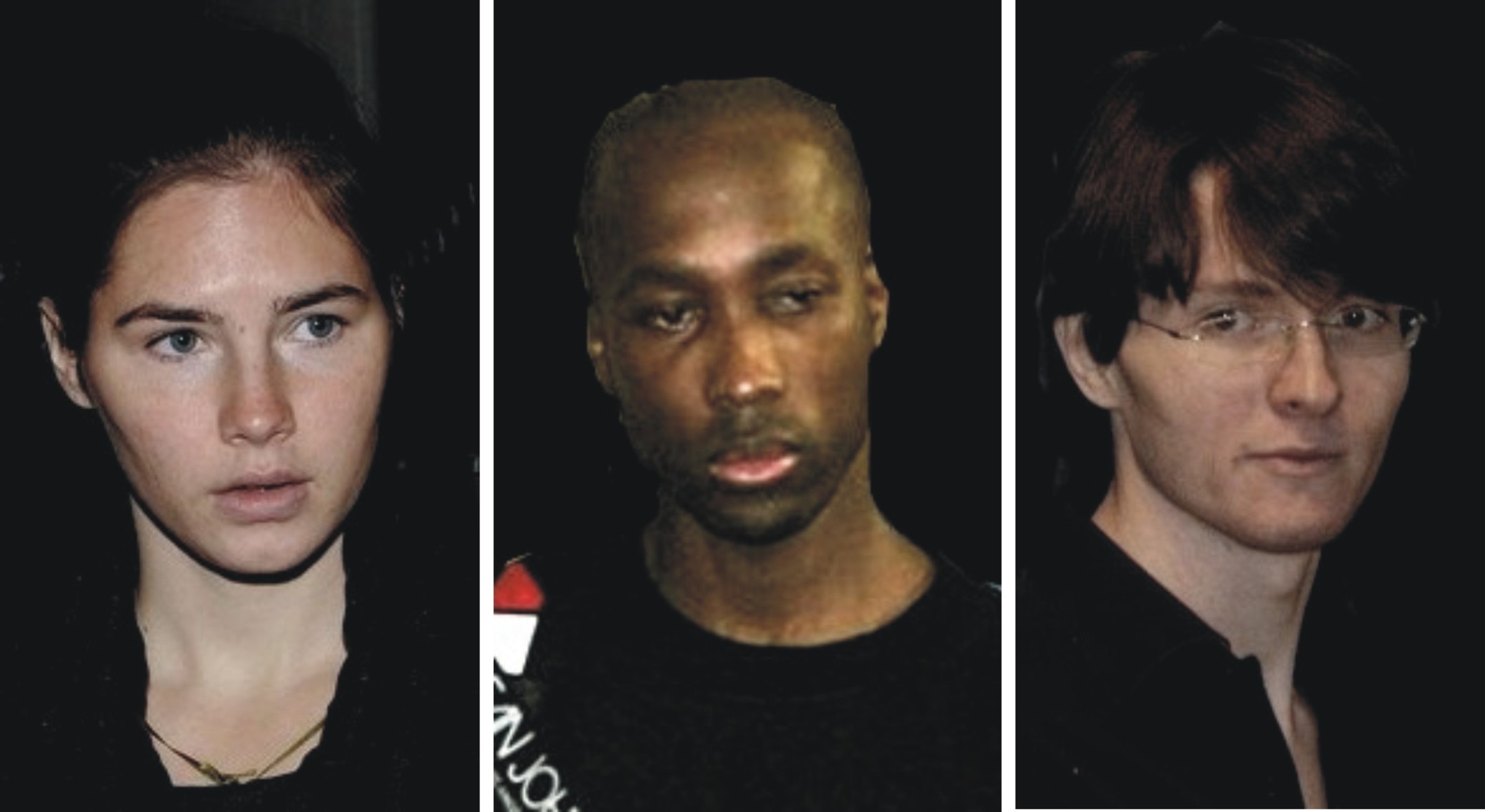
This is my post on my website Man From Atlan of June 26, 2011 cross-posted here at the invitation of TJMK.
Due to my Scorpionic nature, I think, I come across a great many criminal and legal cases that grab the public attention.
It seems, also, that I get involved in the case in one way or the other, and, a great number of coincidences seem to er, follow me. Psychologists call that the ‘I was there syndrome’ and that’s fine, it’s a form of mental illness, and you can decide if I have it, or not!
But I have spent a lifetime studying the fine line between Psychic Sensitivity and Schizophrenia, and what interests me here is not only how we identify with the crime and the individuals involved, but how these cases establish themselves in the public consciousness.
And yes, I want to write about the lives wasted, and what might have been.
Whenever a person dies, there is a break in the fabric of consciousness, and all of humanity is affected. Most people learn to ignore it; some, more sensitive, get consumed by it, but we are all affected by it at some level.
A murder case may be just one individual; the devastation of an earthquake or tsunami may affect hundreds of thousands. As for me, I am an observer, but also in a way, a catalyst.
Look, you know my spiritual claims. Forget that for a moment. What I do is warn people about the fateful consequences of the psychic and spiritual damage done to our souls (or psyche) and environment, and if you don’t listen, if you don’t change, then so be it. What will be, will be. But a part of me, having seen what would happen, mourns for what might have been.
One of my patients was a girl who had Rhett’s Syndrome, a severe form of Autism. She came to my clinic and the treatments really helped, yet it was the mother who also needed help. In the end, suffering from depression, she killed her child and tried to commit suicide.
A woman two streets down from us, suffering from post partum depression, killed her husband and stabbed her two children as well. My son used to play with their dog at the local park, but curiously, I never met them.
I worked on a mayoralty campaign. The candidate, a lovely soul, came second. At the farewell party I saw something dark around him. I told his partner that he needed help, and offered. It wasn’t heard because they were, I think, already caught up in their karma. A year later he jumped off a bridge and killed himself.
Then, going from the personal to the ‘famous’ cases, and the ‘coincidences’ and lessons thereof.
I wrote in “Michael Jackson, the Drowning Man” about how I helped a famous musician with his Parkinson’s Disease in 1994 but when I asked him to introduce me to Michael Jackson, he didn’t. I was too controversial. Pity, I could have helped him before he descended into his inappropriate behavior.
OJ Simpson was the first criminal case. I lived in Santa Monica almost equidistant between him and his ex-wife Nicole Brown. I had driven around the neighborhood enough times to know the story had some inconsistencies, but I believed he was guilty. I also accepted the jury’s verdict of Not Guilty, because the principle of reasonable doubt, in American law, had to be upheld.
There also was the fact I had closed my practice in Toronto and moved to Los Angeles just to help people there, arriving in 1993 in time for the Malibu Fires and Northridge Earthquake (written in “A Spiritual Journey To The United States”) and once I knew my work was done left for Texas. And a few months later, the murder, the White Bronco slowly driving down the freeway, the media circus and all of LA enjoying a mass catharsis.
After I left the US in 1995 I shifted my focus to Europe, though Canada remained my home base. I still looked back to the US with fondness, and sadness for what was yet to come.
I was in England in 2005 when the Terri Schiavo case gripped the nation. She was in a lengthy coma, with most of her brain destroyed. Her parents were fighting to keep her on life support, while her husband wanted to pull the plug and let her die.
I tried to stay uninvolved, even though I knew her spirit wanted to be free. I felt this was wrong, for parents to keep holding on to their child. So one day, when Chloe called me about the latest developments, I said enough was enough, and helped her spirit pass on. She died that evening. And shortly after I left England, there was the London Tube bombing. Coincidence, or catharsis?
Madeleine McCann, a little girl from the U.K., disappeared from her holiday bedroom in Portugal just a few days before her 4th birthday, in May of 2007. Her parents were dining some distance away with their friends and inexplicably had left the children unattended and the door to their villa unlocked. The investigators never found Madeleine. The conclusion, absent a body, was that she had been kidnapped. There were many false sightings after that, as people assumed she had been kidnapped by child traders.
This was two months before I went to the UK with my family on holiday. I was asked what I thought about Madeleine. Would she be found? I replied that she had died that first night, and the parents were involved in a cover up. The person who asked me that question then consulted a psychic, who of course said what everyone wanted to hear: Madeleine was alive.
Then further reports came out, and we found that special police dogs, trained to sniff for evidence of death, had indicated she had died inside the bedroom that very night. Nothing further came to light, as political interference corrupted the whole process, and police investigators were sacked for ‘unfairly blaming the parents’
Yet, there’s a website that does just that; you be the judge. See here and here and here.
This was another example of a case that would consume the public, as so many identified with the missing child, or the parents. And, as always, my presence seemed coincidental to a whole series of events. A few weeks before we arrived in Glasgow, bombers hit Glasgow airport with a van loaded to the top with propane cylinders, the rains hit the whole country for three months straight, and the biggest floods in over a century inundated large parts of Southern England. Yet wherever we went, there was sunshine…This is the dichotomy of healing, that there can be sunshine, but also, darkness.
I had already arranged to go back to the UK for a month as a consultant. I returned to Canada on October 31.
The very next day, on November 1, 2007, British student Meredith Susanna Cara Kercher, was murdered in Perugia, Italy. Her roommate, Amanda Marie Knox, was convicted of the murder, as was her boyfriend, Raffaele Sollecito, and Rudy Hermann Guede, a drifter from the Cote de Ivoire in Africa.
I hadn’t read much about the case and trial, but came across it on the pages of Huffington Post, the social news website. Here was a full blown narrative: Amanda Knox was innocent of the crime, she was the victim of a corrupt Italian prosecutor, and Rudy Guede was the sole perpetrator (All untrue, btw)
What piqued me was the fingerprints of an extensive PR campaign to manipulate public opinion so as to influence the outcome of a trial in another country. Appearances by Knox’s family on Oprah, calls to boycott Italy, politicians trying to intervene in a judicial process, oh my.
And the comments on the numerous Amanda threads were funny, and so sad. These people were, in a word, disturbed. They were even foul mouthed about the victims parents, for daring to say they felt justice had been served. And they had no compunction about blatant lying and slander either.
I’d seen this so many times, the ease with which people could be led to believe, on the basis of something they saw or read, the most outlandish things.
Now I really do believe that trying to convince True Believers is a waste of time. (But arguing with them can be er, illuminating:) I’m interested in the process by which they come to that belief, but any good book on mob psychology can give you the basics, and of course, you must always read Orwell’s 1984. The same principles of propaganda used to create support for war can also be used to support a position, no matter how wrong it might seem to the intelligent observer.
So I looked at the facts of the case. Amanda Knox had falsely accused her black boss, Patrick Lumumba of the crime, she and her boyfriend had provided alibis that were later disproved, there was a staged break in to mislead the investigation, and there was sufficient DNA, blood and foot prints to prove the complicity of the other two accused.
Two courts, led by Judges Micheli and Massei, had already looked at over 10,000 pages of evidence to conclude that Amanda Knox and Raffaele Sollecito had also been involved in the murder. And, the most compelling DNA evidence, Raffaele’s DNA on the victims bra, and Amanda’s DNA mixed with Meredith’s on the murder knife found in Raffaele’s flat.
The Supreme Court of Italy, while affirming Rudy Guede’s conviction, had already established that more than one attacker had been involved, and that DNA attributed to Knox and Sollecito had already been found.
I also noted that the Wikipedia page on Meredith Kercher, once reflecting the findings of guilt against all three accused, had now been hijacked by, let’s say, Amanda Knox partisans.
I have to thank the two websites TJMK and PMF for the fine work they have done compiling and translating the vast volume of Italian language transcripts of the trial and summaries of evidence. Without them, my technical knowledge of the case would have been quite inadequate. I can’t recommend them highly enough for anyone interested in learning about the case.
But I formed my opinions way before I found their sites, and I say this out of respect: I don’t want their work compromised by association with my own views.
What I write about here is first and always, spiritual in nature. I may use logic to confirm something, I will look at evidence, but ultimately I look at disturbances in the fabric to search out imbalance and untruth. And I learn to trust my instincts. It is only afterwards that I look at other factors, and if I need to adjust my views, so be it. But the patterns and the coincidences, are fascinating.
First, the Astrology. Meredith Kercher, born Dec. 28, 1985, and Rudy Guede, December 26, 1986, are both Capricorns. Raffaele Sollecito, March 26, 1984, is Aries, and Amanda Knox, July 09, 1987, a Cancer. Their signs form a T-Square, at 90 degrees to each other, which are widely seen as indicators of stress and incompatibility. The day of the murder saw widespread stressors on all their horoscopes which would lead to murder, detection, conviction and imprisonment. The Astrology even shows Raffaele’s drug dependency and mental confusion on the night of the murder, the conflict between Amanda and Meredith, and the violence and rage that simmered just below the surface of Amanda Knox’s psyche.
And the night of the murder, November 1, 2007, saw Saturn and Venus in the house of emotional excess, Uranus in the house of sudden death, and Jupiter/Pluto, in the sexual house, in an almost exact T-Square to each other. The close conjunction of Pluto to the Milky Way’s Galactic Center shows the potency of this murder in attracting the public imagination, and also, the trigger for the murder.
But Astrology is just one of many tools in Humanistic psychology. It shows patterns, yes, but mainly it gives a picture of motivations and stages of development. And sometimes, it tells us what might happen. For me, there are many tools: Psychism to know, and other tools to understand.
So I will say this about all four:
Amanda Knox’s profile is that of the self destructive individual who will fall from ‘the shattered tower’ due to her associations with others. Btw, her July 09 birthday is the same as OJ Simpson’s and they Both Wielded Knives, hmmm!
Raffaele Sollecito has powerful friends who won’t be able to help him. He almost had it too easy, and his drug use took him into some deep dark spaces. Note he wasn’t just using cannabis, but more likely a potent form called skunk weed, plus heroin and cocaine.
Rudy Guede may actually turn out to be a sympathetic individual. His is the one chart I see that leads to redemption and indescribable potential. He is, quite frankly, the most believable of the three, even though he did lie, and he was rightly found guilty.
Meredith Susanna Cara Kercher was greatly loved, had the intellectual capability to go far, and would have, if she hadn’t been murdered, been a bright blazing star. RIP Meredith.
I hate to make predictions. Human beings will always have the capacity to alter the future (though truth be told, not as much as they like to think) My prophecies have to do with the future of this planet and humanity’s ability to survive and regenerate itself.
But on June 27, Rudy Guede will face Amanda Knox and Raffaele Sollecito in their appeals trial, and for the first time, be forced to answer questions directly. I believe this will be the day he begins to redeem himself.
(Update: And on that day, he placed Amanda Knox and Raffaele Sollecito at the crime scene)
On June 30th, the DNA experts will present their findings. This will be one day before the solar eclipse in Cancer. I predict bombshells in court.
(Update: the expert’s report was presented a day earlier, on June 29, and it was interesting, to say the least. It disputed some of the DNA findings accepted by the previous court and one would think from the media reporting they prove Knox and Sollecito’s innocence. From my reading of the report, it does no such thing, only places ambiguities on some of the evidence. There definitely will be fireworks in court, as the prosecution tears into the many errors of the report)
I am struck by the coincidences of the cases I outlined: allegations of prosecutorial and judicial misconduct, disputed forensic and DNA evidence, racism and political interference, your standard trial. But they all, held a special place in the public imagination.
But in spiritism we see that it is the unquiet spirit of the victim that calls to us, and we can only hope and pray for their peace. Justice is always done.
And one can only look back at them with sadness, for what might have been.
Tuesday, April 12, 2011
Explaining The Massei Report: How Motive For The Crime Is Addressed By Judge Massei
Posted by James Raper
The March 2010 Trial Sentencing Report
The Massei Report in the main I thought was excellent. He was incisive with his logic, particularly, though not exclusively, with regard to the staging of the break in and how that necessarily meant that Amanda was present at the scene when the murder was committed.
However, I thought that he was rather feeble in his coverage of the defendants’ motives as to the attack which led to this brutal murder.
Perhaps he thought it better to stick with the indisputable evidence. Since this pointed to a sex attack he surmised that Guede had a go at Meredith first, and then - because the stimulation was too much for them - he was joined by Amanda and Raffaele. This works but does seem a bit weak.
Micheli, the judge who committed Amanda and Raffaele to stand trial, was more certain in his mind as to the roles played by these three. He said that there was “an agreed plan”, “to satisfy sexual instincts” with “murderous intent” and that effectively Amanda was the instigator and catalyst.
Motive is largely an area of speculation but it is surely possible to draw inferences from what we know? As Micheli did. The Appeal Court and ultimately The Supreme Court of Cassation may well adopt the same reasoning and conclusion - maybe go further.
And there were, to my mind, undoubtedly many factors at work, and it is these which I wish to address. I have always been interested in the possible dynamics of just how these three came to murder poor Meredith. Pro-Knox campaigners once made much of “No Motive”. Now not so much, because the issue draws people in to a discussion of the evidence and of Amanda’s personality.
For instance, Massei asks, though he says we can not know, had Amanda egged Guede on as to the “availability” (my word, not his) of Meredith during or prior to their presence at the Cottage?
Frankly the answer to that has to be “yes” since it is a bit difficult to figure out why Amanda and Raffaele would otherwise wish Guede to join them at the cottage. I doubt that Amanda and Raffaele would have wanted Guede around if they were just going there to have an innocent cuddle and sex and to smoke cannabis, as Massei implies. The evidence is that Raffaele hardly knew Guede and in the presence of Amanda was very possessive about her. If he had known of Guede’s interest in Amanda, he would have been even less keen to have Guede around.
Also, if all was so innocent beforehand, then why would Guede have tried it on with Meredith, and then pressed the situation in the face of her refusal to co-operate? Knowing that there were two others there who could have come to her assistance?
The answer is of course that Guede knew full well in advance that there would be no problem with Amanda and Raffaele. He had been invited there, and primed to act precisely in the way he did, at least initially. Why? Well there is plenty of evidence as to why Amanda, in her mind, may have been looking for payback time on Meredith. Come to that later.
What does not get much attention in the Massei Report, other than a terse Not Proven at the end, is the matter of Meredith’s missing rent money and credit cards and whether Amanda and Raffaele stole them. It is as if the Judge (well, the jury, really) felt that this was a trivial issue that brought nothing much to the case, and thus it was not necessary to give it much attention. And indeed there is no summation of or evaluation of that evidence.
Now that does surprise me. Of course there may have been some technical flaw with the charge and the evidence. But in the absence of any comment on this then we do not know what that may be.
What I do know is that the matter, if proven, is not trivial. A theft just prior to the murder significantly ups the stakes for Amanda and Raffaele, and produces a dynamic, which, threaded together with a sexual assault, makes for a far more compelling scenario to murder. It also leads one to conclude that there was a greater degree of premeditation involved: not premeditation as to murder, but as to an assault, rather than the more spontaneous “let’s get involved” at the time of the sex attack as postulated by Massei.
What is the evidence? What evidence was before the court? I do not yet have access to trial records. Therefore I stand to be corrected if I misrepresent the evidence, or if my interpretation of it does not met the test of logic.
There were two lay witnesses to whom we can refer. The first was Filomena Romanelli, the flatmate and trainee lawyer. If there was anyone who was going to ensure that the rent was paid on time, it would have been her. She gave evidence that, the rent being due very soon, she asked Meredith about her contribution of 300 euros, and was told by Meredith that all was OK because she had just withdrawn 200 euros from her bank. Filomena assumed from Meredith’s reply that the balance was already to hand.
Is there a problem with this evidence? Is it hearsay and thus inadmissible under Italian law?
Perhaps it is not enough by itself because of course had Meredith not in fact withdrawn the money from her bank, or sufficient funds to cover the stated amount, then that would be a fatal blow to that part of the theft charge. Her bank manager was summoned to give evidence, essentially to corroborate or disprove Filomena’s testimony. I do not know what exactly that evidence was. One would assume that at the very least it did not disprove her testimony. Had it done so, that would as I have said been fatal. It is also unbelievable that Massei would have overlooked this in the Report. I am assuming that Meredith did not tell a white lie, and that the bank records corroborate this.
There may of course be an issue of timing as I understand that the bank manager told the court that transactions at a cash machine are not necessarily entered on the customer account the same day . However that does not seem to me to be significant.
One must also think that the bank manager was asked what other cash withdrawals had been made if the credit cards were taken at the same time as the money.
I understand that there is of course a caveat here: my assumptions in the absence of knowing exactly what the bank manager’s evidence was.
It would be useful also to know how and when the rent was normally paid. It sounds as if it was cash on the day the landlord came to collect.
We do know that the police did not find any money, or Meredith’s credit cards. Had Meredith, a sensible girl, blown next month’s rent on a Halloween binge? Unlikely. So somebody stole it. And the credit cards? Again, just as with the fake break in, when according to Amanda and Raffaele nothing was stolen, who and only who had access to the cottage to steal the money? Yes, you have guessed it. Amanda, of course.
Does the matter of missing rent money figure anywhere else? There is the evidence of Meredith’s phone records which show that a call was placed to her bank late on the evening of her murder just prior to the arrival of Amanda, Raffaele and Guede. Why? I have to concede that there is no single obvious reason and that it may be more likely than not that the call was entirely unintentional.
But if, as may seem likely, the credit cards were kept with her handbag, and the money in her bedroom drawer, then on discovering that her money was missing she may have called her bank in a funk, only to remember that the cards were safe and that no money could be withdrawn from her account.
The missing money also figured in the separate trial of Guede. He made a statement which formed the whole basis of his defence. Basically this was that he had an appointment with Meredith at the cottage, had consensual foreplay with her, and was on the toilet when he heard the doorbell ring etc, etc. What he also added was that just before all this Meredith was upset because her rent money had disappeared and that they had both searched for it with particular attention to Amanda’s room.
Now why does Guede mention this? Remember this is his defence. Alibi is not quite the right word. He had plenty of time to think about it or something better. His defence was moulded around (apart from lies) (1) facts he knew the police would have, ie no point denying that he was there, or that he had sexual contact with Meredith: his biological traces had been left behind; and (2) facts known to him and not to the police at that stage, ie the money, which he could use to make his statement as a whole more credible, whilst at the same time giving the police a lead. He is shifting the focus, if the police were to follow it up, on to the person he must have been blaming for his predicament, Amanda.
If all three, Amanda, Raffaele and Guede, went to the cottage together, as Massei has it, then Guede learns about the missing rent money, not in the circumstances referred to in his statement, but because Meredith has already discovered the theft, and worked out who has had it, and challenges Amanda over it when the three arrive. Perhaps this is when Guede goes to the toilet and listens to music on his Ipod. After all he is just there for the sex and this is all a distraction.
Although Micheli thought Guede was a liar from start to finish, he did not discount the possibility that Guede was essentially telling the truth about the money. Guede expanded upon this at his appeal, telling the court that Amanda and Meredith had an argument and then a fight over it. It is a thread that runs through all his accounts, from his Skype chat and initial statements in Germany to his final appeal.
Guede’s “evidence” was not a factor in the jury’s consideration at Amanda’s and Raffaele’s trial. Although he was called to give evidence he did not do so. Now his “evidence” and the findings and conclusion of the courts which processed his case come in to play in the appeal of Amanda and Raffaele.
When were the money and credit cards stolen?
I have to accept that, as to the money, at any rate a theft prior to the murder is critical to sustain the following hypothesis. The credit cards were in any event probably taken after the attack on Meredith.
According to Amanda and Raffaele they spent Halloween together at Raffaele’s, and the next day went to the cottage. Meredith was there, as was Filomena. Filomena left first, followed by Meredith to spend the evening with her friends, and Amanda and Raffaele left some time afterwards.
So Amanda and Raffaele could have stolen the money any time after Meredith left and before she returned at about 9.30pm - the day of her murder. Incidentally Filomena testified that Meredith never locked the door to her room except on the occasions she went home to England. Meredith was a very trusting girl.
What motive had Amanda for wanting the money, apart from the obvious one of profit?
There are numerous plausible motives.
To fund a growing drugs habit which she shared with Raffaele? Not an inconsiderable expense for a student. Both Amanda and Raffaele explained during questioning that their confusion and hesitancy was due to the fact that they had been going rather hard on drugs. Mignini says that they were both part of a drugs crowd.
Because her own financial circumstances were deteriorating, and to fund her own rent contribution? She was probably about to be sacked at Le Chic, where she was considered by Lumumba to be flirty and unreliable, and to add insult to injury would likely be replaced by Meredith. In fact Meredith was well liked and trusted by all, whereas Amanda’s star was definitely on the wane.
But maybe Amanda just also wanted to get her own back on Meredith.
Filomena testified that Meredith and Amanda had begun to have issues with each other.
Here are some quotes from from Filomena in “Darkness Descending”.
At first they got on very well. But then things began to take a different course. Amanda never cleaned the house, so we had to institute a rota… then she (Amanda) would bring strangers home… Meredith said she was not interested in boys, she was here to study.
Meredith was too polite to confront Amanda, but she did confide in her pal, Robyn Butterworth. Robyn winced in disbelief when Meredith said that the pair had quarreled, because Knox often failed to flush the toilet, even when menstruating. Filomena began noticing that Amanda could be odd, even mildly anti-social.
It seems that Amanda did not like it when she was not the centre of attention. It was observed that, comically if irritatingly, she would sing loudly if conversation started to pass her by, and when playing her guitar would often strum the same chord over and over again.
On the evening of Halloween, Amanda texted Meredith enquiring as to whether they could meet up. But Meredith had other arrangements. Meredith appeared to be having a good time, whereas Amanda was not.
Indeed there has been much speculation that Amanda has always had deep seated psychological problems and that after just several weeks in Perugia her fragile and damaged ego was tipping towards free fall.
With Meredith’s money, both Amanda and Raffaele could have afforded something a little stronger than the usual smoke, and I speculate that they spent the late afternoon getting stoned.
Of course Amanda was still an employee of Lumumba, and she was supposed to turn up that evening for work, but perhaps she no longer cared all that much for the consequences if she did not.
Again I speculate, that she, with or without Raffaele, met Guede at some time - perhaps before she was due at work, perhaps after she learnt that she was not required by Lumumba - and discussed Meredith’s “availability” and agreed to meet up again on the basketball court at Grimana Square.
The notion that Amanda and Guede hardly knew each other seems implausible to me. We know that they met at a party at the boys’ flat at the cottage. Guede was friends with one of those boys and was invited there on a number of occasions. He was ever-present on the basketball court in Grimana Square, which was located just outside the College Amanda and Meredith attended, and just metres from the cottage. He was known to have fancied Amanda, and Amanda was always aware of male interest.
What else did Amanda and Raffaele have in mind when arranging the meeting or when thinking about it afterwards?
Guede was of course thinking about sex and that Amanda and Raffaele were going to facilitate an encounter with Meredith later that evening. However Amanda and Raffaele had something else on their minds. The logic of their position vis a vis Meredith cannot have escaped them. They had taken her money whilst she was out.
Had she not already discovered this fact then she would in any event be back, notice the money was missing and would put 2 and 2 together. What would happen? Who would she tell? Would she call the police? How are they going to deal with this? Obviously deny it, but logic has its way, and the situation with or without the police being called in would be uncomfortable.
They decided to turn the tables and make staying in Perugia uncomfortable for Meredith? Now the embarrassing, for Meredith, sexual advances from Guede were going to be manipulated by them in to a sexual humiliation for Meredith. Meredith was not going to be seriously harmed, but as and when they were challenged by Meredith over the missing money, as inevitably they would be, she was to be threatened with injury or worse. Knives come in useful here.
Amanda may have fantasized that Meredith would likely then give up her tenancy at the cottage, perhaps leave Italy. Whether that looks like the probable and likely outcome, I leave you to judge, but the hypothesis is that they were starting to think and behave irrationally and that this was exacerbated by the use of drugs.
In the event there came a point when neither Amanda nor Raffaele had any other commitments anyway. They got to the basketball court. They waited for Guede.
We know Amanda and Raffaele were on the basketball court the evening of the 1st November. This is because of the evidence of a Mr Curatolo, the second lay witness. He was not precise about times but thought that they were on the basketball court between 9.30pm and 10pm and may have left around 11.00 - 11.30pm and then returned just before midnight.
In any event he testified to seeing Amanda and Raffaele having heated arguments, and occasionally going to the parapet at the edge of the court to peer over. What were they looking at? Go to the photographs of Perugia on the True Justice for Meredith website, and you will see. From the parapet you get a good view of the iron gates that are the entrance, and the only entrance as I understand it, to the cottage.
So why the behaviour observed by Mr Curatolo? They may have been impatient waiting for Guede to arrive. Were they actually to go through with this? Was Meredith at home, alone, and had she found the money was missing and had she called the police or tipped off someone already? Who was hanging around outside the entrance to the cottage and why?
There was, apparently, a car parked at the entrance, a broken down car nearby with the occupants inside awaiting a rescue truck, and the rescue truck itself, all present around 11.00pm. Amanda and Raffaele did not wish to be observed going through the gates with these potential witnesses around.
We of course cannot know for certain what went on in the minds of Amanda and Raffaele between the time of them leaving the cottage and their departure from the basketball court to return to the cottage. It has to be speculation, but there is a logical consistency to the above narrative if they had stolen Meredith’s money earlier that day, and their meeting up with Guede just before leaving the basketball court does not look like a coincidence.
From there on in to the inevitable clash between Amanda and Meredith over the money.
It is my opinion that at the cottage Amanda came off worse initially: that she got caught in the face by a blow and suffered a nose bleed.
Experts Stefanoni and Garofano both say that there was an abundant amount (relatively speaking) of Amanda’s blood in the bathroom washbasin, and to a lesser extent the bidet. Whereas most of Amanda’s blood in the bathroom was mixed with Meredith’s, the blood on the washbasin tap was Amanda’s alone. Both of a quality and quantity to discount menstrual (from washed knickers) or bleeding from ear-piercing. Their conclusion was that Amanda bled fairly profusely though perhaps briefly at some stage.
Possibly Amanda may have cut her feet on glass in Filomena’s bedroom but if so it’s difficult to see how blood from that ends up as a blob on the basin tap and in the sink, and cut feet are painful to walk on and she did not display any awkwardness on her feet the next day.
Amanda’s blood may have come from a nick by a blade to her hands. I think the nick would be obvious the next day. If so, she was not hiding it. She was photographed the next day outside the cottage waving her hands under the noses of a coterie of vigilant cops.
She might have got a bloody nose during the attack in Meredith’s bedroom save that there is no evidence of her blood there.
On the other hand if she got into a tussle with Meredith (say in the corridor outside their rooms and where there was little room for other than the two to be engaged) and was fended off with a reflex blow that accidentally or otherwise connected with her nose, Amanda’s natural reaction would be to disengage immediately and head for the bathroom sink to staunch the flow of blood.
A nose-bleed need not take too long to staunch, especially if not serious and if there is no cut (certainly none being visible the next day). Just stuff some tissue up the offending nostril. A nose bleed is not necessarily something of which there would be any sign the next day.
Raffaele fusses around her, whilst Rudy briefly plays peacemaker. But Amanda is boiling. As furious with Raffaele and Guede as she is with Meredith. She eggs Guede on and pushes him towards Meredith. Raffaele proudly produces his flicknife, latent sadistic instincts surfacing.
Is a scene like this played out inside the cottage or outside? I think of the strange but sadly discredited tale told by Kokomani.
In any event motive is satiated and the coil, having been tensed, is sprung for the pre-planned, but now extremely violent, hazing of poor Meredith.
I am also thinking here of Mignini’s “crescendo of violence” and where a point is reached where anything goes ““ where there is (from their warped perspectives) almost an inevitability or justification for their behaviour. A “Meredith definitely needs teaching a lesson now!” attitude.
Psychology is part of motive and there is much speculation particularly with regard to Amanda and Raffaele. They have both been in prison for well over three years now and during this time psychological assessments will certainly have been carried out.
Based on specific incidents and and general patterns of behaviour, speech and language, and demeanour, some preliminary conclusions will have been reached correlated with the facts of the crime.
If their convictions are upheld, these assessments may be relevant to sentence insofar as they shed light on mitigation and motive.
Saturday, March 05, 2011
Thoughts On Meredith’s Tragic Case And Its Significance In The Bigger Scheme Of Things
Posted by Saskia van der Elst
As one of the regular commentators on this forum once pointed out, the question we all are trying to answer regarding the pointless murder of the talented and beautiful Meredith Kercher in Perugia is: What is it, that keeps on drawing us to this case?
We all have our own reasons. According to me, a murder case seldom has so much in common with an old school murder mystery, or “whodunnit”. A victim that you instantly sympathize with, several suspects, each with their own particular background, ethnic origin and possible motives, a tragic event taking place on the day of the Death, a charismatic prosecutor, who himself is the center of some controversy, and all of this set in the stunningly beautiful medieval hilltop town of Perugia, with its two universities, its relatively small population and its many temporary residents, studying and partying in the small town center.
All are ingredients for a captivating story: a small universe, that can easily be explained to an outsider and once you heard the beginning of the story, you crave more. More information, more depth, more color. For those that have a normal, healthy brain, there comes a point in any murder mystery where you are convinced of the guilt of one or more of the characters in the story and as you near the end of the story, there might be an unexpected twist, but you can rest assured that you will find out who did it.
Of course, in real life stories don’t follow formulas, most of the time they don’t have a definitive ending and in the case of the murder of Meredith, the book is not closed. The three perpetrators of the crime have been convicted to a total of 67 years in jail between the three of them, but all three maintain their innocence. We all know that three cannot keep a secret, so it is a matter of time until one of them reveals more about the exact events that took place on the 2nd of November in 2007.
Each of the three perpetrators will go through a process of maturing in prison. Once they feel they have paid a significant price for their crime, they may realize the graveness of they crime and realize that they made bad decisions in their past. Not until that moment, they can find redemption and may feel the need to let the world know that they have changed as a person. All three perpetrators were immature in their own way when they committed their crime, so it might take a while for them to mature enough to be able to face reality.
Rudy might be the first one to reach that point, since he is more or less an orphan, with no controlling relatives, friends and others with vested interests in the lies that have masked the truth. Nobody will lose face if he decides to confess his participation in the crime. The same thing, but to a lesser degree, is true for Raffaele. Since he never even cared about clarifying all inconsistencies in his stories, he implicitly has already admitted his involvement. He too, doesn’t affect many people if he opens up and gets clean. The only close relatives he has are his father and sister and they have not publicly expressed a strong believe in his innocence.
Amanda is in a much more difficult position, because of the amount of people that was mobilized to defend her. By now she has been the income generator for quite some people and although nobody envies her parents, they have a clear mission, that keeps them occupied and that gives their lives meaning. The moment Amanda would confess her involvement, the parents would be forced to exchange the “free my innocent daughter” banner for one that reads “I raised a murderess that is serving two and a half decades in a foreign prison”.
On top of the above, the process of coming clean might be a slow one, because all three suffer from uncertainty about how the other two are doing. That uncertainty might cause postponing the advance, until they are forced to speak up, because one of the others did so first.
The result for those that are following the case is that we know we don’t have all information yet and for us to fill in all the blanks and be able to understand what exactly has happened to Meredith we need that information. Until we have it, we cannot accept the story as is as it leaves us unsatisfied. Of course we are talking about a true story here and not about a work of fiction, but for the rational part of our minds that doesn’t make a difference.


